Most innovative companies for 01/02/2024 (new inventions)
Exciting new inventions from Qualcomm Incorporated, Samsung Electronics Co., Ltd., Apple Inc., Amazon Technologies, Inc. And Micron Technology, Inc.
This is a weekly article summarizing a handful of inventions from the most innovative companies in the world. The summaries are created by an A. I. and proof-read by a human before publication. Attempts are made to ensure accuracy of the descriptions, but it is very much a work in progress. Each invention description is preceeded by a poem about the invention that is written by the A. I. I have found the limerick is actually quite good at explaining the invention in simple terms. Enjoy!
Apple Inc.
"Apple's Wireless Wearable Patent Revolutionizes Personal Fitness Monitoring"
What is this invention?
Wearable computer with fitness machine connectivity for improved activity monitoring using caloric expenditure models
There once was a wearable computer,
That connected to a fitness machine, no other.
It tracked heart rate and more,
To measure calories galore,
Sending data to improve your workout endeavor.
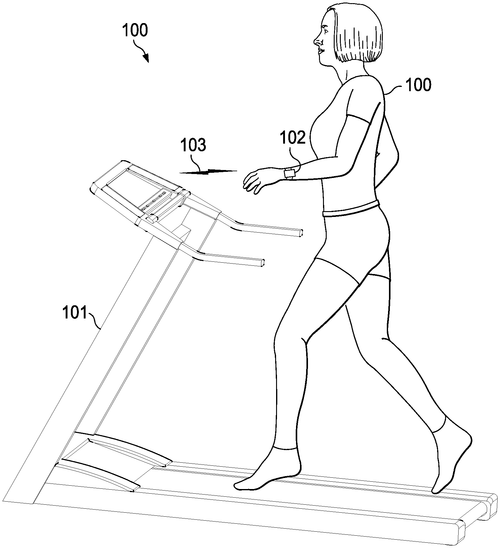
Apple Inc. has recently filed a patent that could revolutionize workout sessions on fitness machines. The patent describes a method in which a wireless wearable computer connects with a fitness machine to collect data during a workout session. The device obtains machine data, such as distance covered and resistance levels, while also capturing the user's heart rate data through a built-in heart rate sensor. Using this information, the wearable computer applies various models to determine the user's work rate caloric expenditure, calibrated maximal oxygen consumption, and heart rate caloric expenditure. The most intriguing aspect of the patent is that it allows the device to send this data back to the fitness machine via a wireless communication connection. This technology, if developed into a product, could greatly enhance workout experiences at the gym or at home. Imagine a scenario where you're on the treadmill, and the machine adjusts its settings based on your heart rate or calorie burning goals. It could create a personalized workout tailored to your fitness level and objectives. While Apple's patent seems promising, it's worthwhile to note that there are already similar products on the market. Competitors like Fitbit and Garmin offer fitness trackers with heart rate sensors that can provide users with some of the same information. However, the ability to send this data back to the fitness machine sets Apple's patent apart. But as with any patent, it's uncertain whether Apple will actually develop and release a product based on this technology. Many patents never see the light of day, remaining purely conceptual ideas. So, the question arises: would you be interested in a wearable technology that seamlessly integrates with your gym equipment? How do you envision this technology improving your workouts? Let us know in the comments below!
Abstract
In an embodiment, a method comprises: establishing, by a wireless wearable computer worn by a user, a wireless communication connection with a fitness machine; obtaining machine data from the fitness machine while the user is engaged in a workout session on the fitness machine; obtaining, from a heart rate sensor of the wireless device, heart rate data of the user; determining a work rate caloric expenditure by applying a work rate calorie model to the machine data; determining a calibrated maximal oxygen consumption of the user based on the heart rate data and the work rate caloric expenditure; determining a heart rate caloric expenditure by applying a heart rate calorie model to the heart rate data and the calibrated maximal oxygen consumption of the user; and sending to the fitness machine via the communication connection, at least one of the work rate caloric expenditure or the heart rate caloric expenditure. In an embodiment, a method comprises: establishing, by a wireless wearable computer worn by a user, a wireless communication connection with a fitness machine; obtaining machine data from the fitness machine while the user is engaged in a workout session on the fitness machine; obtaining, from a heart rate sensor of the wireless device, heart rate data of the user; determining a work rate caloric expenditure by applying a work rate calorie model to the machine data; determining a calibrated maximal oxygen consumption of the user based on the heart rate data and the work rate caloric expenditure; determining a heart rate caloric expenditure by applying a heart rate calorie model to the heart rate data and the calibrated maximal oxygen consumption of the user; and sending to the fitness machine via the communication connection, at least one of the work rate caloric expenditure or the heart rate caloric expenditure.
US Patent 11857143
QUALCOMM Incorporated
"Qualcomm's Patent Enables Safe Vehicle Operations Through Gesture Control"
What is this invention?
Gesture-based control for semi-autonomous vehicle
In vehicles of future we roam,
Gestures will guide us back home.
Passenger profiles,
Normalize the trials,
Safety's upheld as we roam.

A recent patent filed by QUALCOMM Incorporated has raised eyebrows with its groundbreaking concept of operating a vehicle based on vehicle-control gestures made by the occupant. While the patent describes various embodiments, including the use of semi-autonomous vehicles, the underlying idea is to determine safe vehicle actions based on passenger gestures. Under this system, a first vehicle action is determined by applying a specific passenger profile to a detected vehicle-control gesture made by the passenger. If the action is deemed safe, the vehicle then proceeds to implement it, ensuring the safety of both the vehicle and its occupants. To normalize vehicle-control gestures, the first passenger profile is selected from multiple profiles available. However, in instances where the determined vehicle action is deemed unsafe, the system offers alternatives. It either ignores the gesture altogether or performs a vehicle action that is similar to the original but safer for all parties involved. While this patent is undoubtedly promising, it remains to be seen if and when QUALCOMM Incorporated will transform it into a viable product. As with any innovative idea, there are numerous obstacles to overcome. Competitors in the market, such as Tesla and Waymo, have already established themselves as pioneers in the realm of autonomous vehicles. Therefore, QUALCOMM will need to prove that their approach offers a significant advantage over existing technology. One can imagine several potential uses for such a system. For instance, it could enhance the driving experience for disabled individuals, empowering them with a new level of control and independence. Additionally, it could contribute to improved road safety by providing an alternative mode of operation when traditional controls are compromised. While the concept outlined in this patent seems promising, it is crucial to remember that not all patents translate into tangible products. So, the question remains: Do you think this proposed vehicle-control gesture system could revolutionize the way we interact with our vehicles, or is it merely a pipe dream? Share your thoughts in the comments below.
Abstract
Various embodiments include methods and vehicles, such as a semi-autonomous vehicle, for safely operating a vehicle based on vehicle-control gestures made by an occupant. Exemplary implementations may include determining a first vehicle action by applying a first passenger profile to a detected first vehicle-control gesture performed by a first passenger, determining whether the first vehicle action is safe to perform, and operating the vehicle to implement the first vehicle action in response to determining that the first vehicle action is safe for the vehicle and occupants. The first passenger profile may be selected from a plurality of passenger profiles to normalize vehicle-control gestures received from the first passenger. The vehicle control gesture may be ignored or a vehicle action differing from but similar to the first vehicle action may be implemented in response to determining that the first vehicle action is unsafe for the vehicle or occupants. Various embodiments include methods and vehicles, such as a semi-autonomous vehicle, for safely operating a vehicle based on vehicle-control gestures made by an occupant. Exemplary implementations may include determining a first vehicle action by applying a first passenger profile to a detected first vehicle-control gesture performed by a first passenger, determining whether the first vehicle action is safe to perform, and operating the vehicle to implement the first vehicle action in response to determining that the first vehicle action is safe for the vehicle and occupants. The first passenger profile may be selected from a plurality of passenger profiles to normalize vehicle-control gestures received from the first passenger. The vehicle control gesture may be ignored or a vehicle action differing from but similar to the first vehicle action may be implemented in response to determining that the first vehicle action is unsafe for the vehicle or occupants.
US Patent 11858532
QUALCOMM Incorporated
"Wearable Ring Device Brings Extended Reality to Your Fingertips"
What is this invention?
Wearable ring device and user interface processing
In a land where wonders unfurl,
A ring for the curious curl.
With sensors that spin,
Extended views win,
To XR, this device is a pearl!
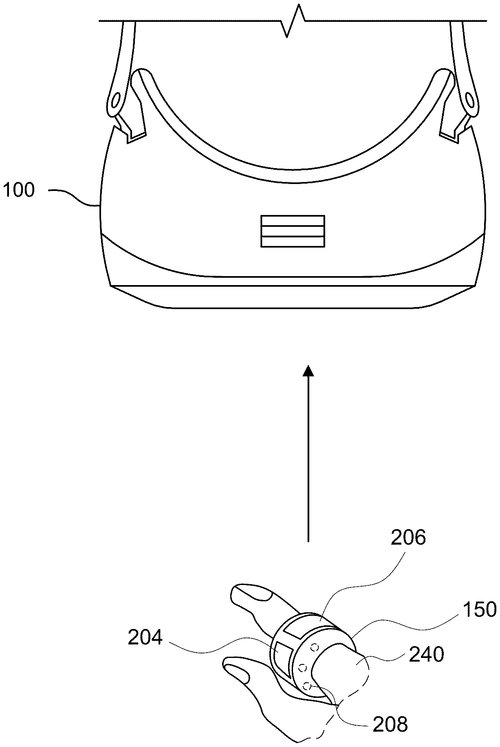
In a recent patent application, Qualcomm has proposed a wearable ring device that could enhance extended reality (XR) functionalities. The device, if ever developed, could revolutionize the way we interact with XR technology. The concept behind the wearable device is simple yet intriguing. Designed to be worn on a finger, the device includes a structure that securely holds the user's finger. Integrated sensors within the device detect rotations of the structure around its longitudinal axis, while a wireless transmitter sends corresponding data to an electronic device. The potential applications of such a device are vast. Imagine being able to manipulate virtual objects in AR or VR environments simply by rotating your finger. With such precise motion tracking, the limitations of current XR technology could be surpassed, providing a more immersive and intuitive experience for users. While the concept holds promise, it's important to note that this patent is far from a finalized product. Competitors like the Nod ring and the Motiv ring have already attempted to enter the wearable tech space, but their success remains limited. Bringing this particular Qualcomm invention to market would require overcoming numerous challenges. From ensuring accurate and reliable rotation sensing to optimizing power efficiency and ergonomics, there are many obstacles to tackle before this device becomes a reality. Nonetheless, Qualcomm's ingenuity and commitment to cutting-edge technology cannot be ignored. As XR technology continues to grow, it is only a matter of time before wearable devices like this become more prevalent. The question remains: Will Qualcomm be the company to make it happen? What are your thoughts on the potential of a wearable ring device for XR functionalities? Do you believe it could revolutionize the way we interact with extended reality? Share your insights and opinions in the comments below.
Abstract
Systems, methods, and non-transitory media are provided for using a wearable ring device for extended reality (XR) functionalities. An example wearable device can include a structure defining a receiving space configured to receive a finger associated with a user, the structure including a first surface configured to contact the finger received via the receiving space; one or more sensors integrated into the structure, the one or more sensors being configured to detect a rotation of at least a portion of the structure about a longitudinal axis of the receiving space; and a wireless transmitter configured to send, to an electronic device, data based on the rotation. Systems, methods, and non-transitory media are provided for using a wearable ring device for extended reality (XR) functionalities. An example wearable device can include a structure defining a receiving space configured to receive a finger associated with a user, the structure including a first surface configured to contact the finger received via the receiving space; one or more sensors integrated into the structure, the one or more sensors being configured to detect a rotation of at least a portion of the structure about a longitudinal axis of the receiving space; and a wireless transmitter configured to send, to an electronic device, data based on the rotation.
US Patent 11861065
QUALCOMM Incorporated
"Qualcomm's Adaptive Machine Learning Technique Enhances Computational Efficiency on Devices"
What is this invention?
Adaptive quantization for execution of machine learning models
In this world of AI's immense might,
Machine learning models take flight,
Weights quantized with grace,
Inferences they embrace,
Adaptive execution, a new light.
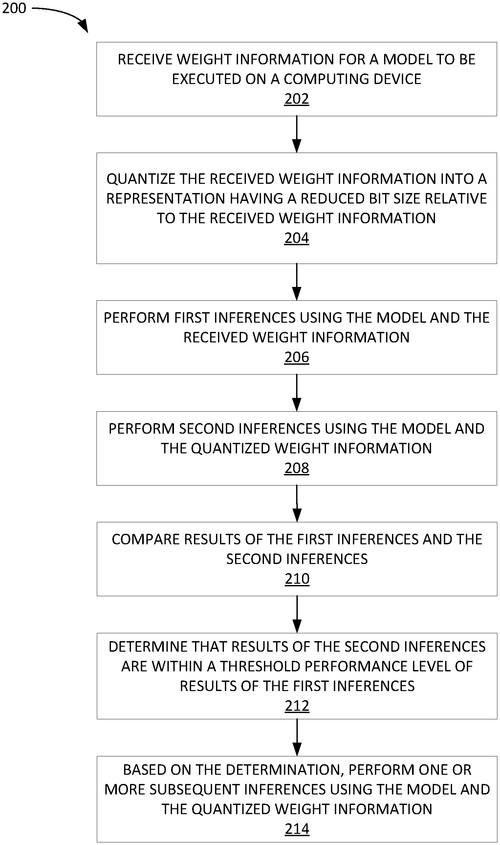
In a recent patent filed by Qualcomm, the company has presented techniques for adaptively executing machine learning models on computing devices. The patent outlines a method that involves reducing weight information for a machine learning model into quantized weight information with a smaller bit size. By comparing the results of the first inferences using the original weight information and the second inferences using the quantized weight information, the system determines if the latter's performance is within an acceptable threshold of the former. If so, subsequent inferences are performed using the quantized weight information. At first glance, this patent seems like a step in the right direction for optimizing machine learning execution on computing devices. The ability to reduce the bit size of weight information could potentially lead to improved efficiency and performance, which could be particularly valuable for resource-constrained devices such as smartphones or IoT devices. However, it is important to note that while the patent describes a method, it does not indicate any actual product or technology implementation. Competitors in the machine learning space, like Google, Amazon, and Microsoft, have been investing heavily in similar advancements. For example, Google's TensorFl. ow Lite offers a machine learning framework specifically designed for mobile and embedded devices, aiming to optimize inference execution with lower memory usage and faster performance. The question that remains is whether Qualcomm will be able to develop this patent into a practical product that can surpass existing solutions. The potential uses for this technology are vast. From enabling real-time computer vision on handheld devices to facilitating more accurate voice recognition on wearables, the ability to adaptively execute machine learning models efficiently can unlock a range of possibilities. However, until we see an actual product or implementation from Qualcomm, it's difficult to assess how impactful this patent will be. What are your thoughts on this patent? Do you believe that Qualcomm will be able to bring this technology to the market, and if so, what potential applications do you envision for it? Let us know in the comments below.
Abstract
Certain aspects of the present disclosure provide techniques for adaptively executing machine learning models on a computing device. An example method generally includes receiving weight information for a machine learning model to be executed on a computing device. The received weight information is reduced into quantized weight information having a reduced bit size relative to the received weight information. First inferences using the machine learning model and the received weight information, and second inferences are performed using the machine learning model and the quantized weight information. Results of the first and second inferences are compared, it is determined that results of the second inferences are within a threshold performance level of results of the first inferences, and based on the determination, one or more subsequent inferences are performed using the machine learning model and the quantized weight information. Certain aspects of the present disclosure provide techniques for adaptively executing machine learning models on a computing device. An example method generally includes receiving weight information for a machine learning model to be executed on a computing device. The received weight information is reduced into quantized weight information having a reduced bit size relative to the received weight information. First inferences using the machine learning model and the received weight information, and second inferences are performed using the machine learning model and the quantized weight information. Results of the first and second inferences are compared, it is determined that results of the second inferences are within a threshold performance level of results of the first inferences, and based on the determination, one or more subsequent inferences are performed using the machine learning model and the quantized weight information.
US Patent 11861467
QUALCOMM Incorporated
"QUALCOMM's Innovative NPU Patent Revolutionizes Neural Processing with Advanced Hardware Pre and Post Processing Capabilities"
What is this invention?
Neural processing unit (NPU) direct memory access (NDMA) hardware pre-processing and post-processing
In the realm of tech, behold the NPU,
With NDMA core, it knows what to do.
A read engine, a buffer, to store,
And a write engine, to process data galore.
With the controller, neural networks come true!
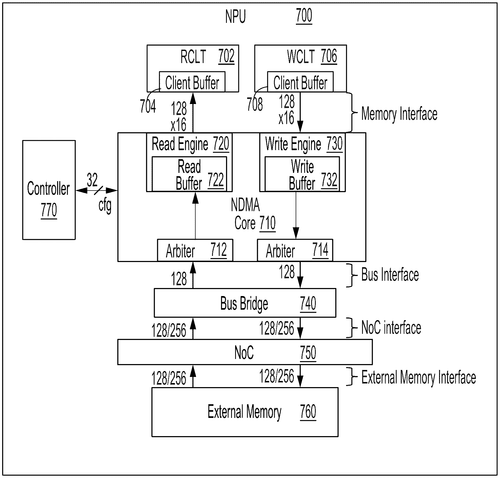
In an exciting development for the field of artificial neural networks, QUALCOMM Incorporated has recently described a new invention—a Neural Processing Unit (NPU). This cutting-edge technology boasts an NPU Direct Memory Access (NDMA) core, equipped with a read engine that has a read buffer, as well as a write engine with a write buffer. The NPU also includes a controller, which directs the NDMA core in performing data preprocessing and post-processing on blocks of a data stripe, in order to process tensors within artificial neural networks. The potential applications for a technology like this are extensive. It could revolutionize the field of deep learning, enhancing the capabilities and efficiency of artificial neural networks across various domains such as image and speech recognition, recommendation systems, and natural language processing. With its hardware-driven approach to data processing, the NPU could significantly accelerate the training and inference phases of neural networks, leading to faster and more accurate results. However, it's important to note that at this stage, the NPU is described solely in a patent. While this demonstrates the innovative thinking of QUALCOMM Incorporated, it does not necessarily guarantee that the technology will make its way into a tangible product anytime soon. Many groundbreaking ideas end up remaining on paper, unable to overcome the challenges of commercialization, competition, or feasibility. Considering the current market, it won't be surprising to see competitors in the field, such as NVIDIA and Intel, exploring similar technologies or refining their existing offerings. It's an increasingly crowded space, and for something like the NPU to thrive, it would need to outshine existing solutions and offer distinctive advantages. As we eagerly await further developments and potential product announcements, your expertise and insights are highly valued. What do you think about the concept of a Neural Processing Unit? How could such a technology shape the future of artificial neural networks? Share your thoughts and opinions in the comments below.
Abstract
A neural processing unit (NPU) is described. The NPU includes an NPU direct memory access (NDMA) core. The NDMA core includes a read engine having a read buffer. The NDMA core also includes a write engine having a write buffer. The NPU also includes a controller. The controller is configured to direct the NDMA core to perform hardware pre-processing of NDMA data in the read buffer and post-processing of NDMA data in the write buffer on blocks of a data stripe to process tensors in artificial neural networks. A neural processing unit (NPU) is described. The NPU includes an NPU direct memory access (NDMA) core. The NDMA core includes a read engine having a read buffer. The NDMA core also includes a write engine having a write buffer. The NPU also includes a controller. The controller is configured to direct the NDMA core to perform hardware pre-processing of NDMA data in the read buffer and post-processing of NDMA data in the write buffer on blocks of a data stripe to process tensors in artificial neural networks.
US Patent 11861484
QUALCOMM Incorporated
"QUALCOMM's Innovative Patent Revolutionizes Ray Tracing with Hierarchical Structure and Graph Cut Techniques"
What is this invention?
Generation of tight world space bounding regions
In ray tracing, a technique fine,
Bounding regions in structures we'll define.
With graph cuts and nodes,
World-space bounding boxes, all in codes,
Determining scenes, our tech will align.
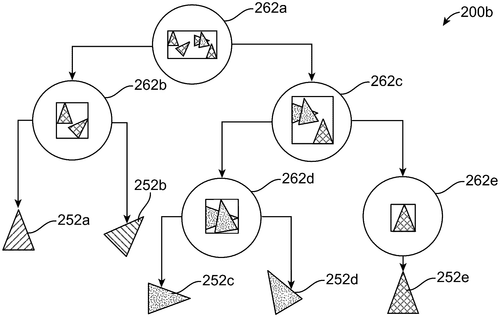
In a recent patent filed by QUALCOMM Incorporated, exciting advancements in ray tracing technology were outlined. Ray tracing, a technique used in rendering realistic images in computer graphics, has gained popularity in recent years. However, the process can be computationally expensive and time-consuming, limiting its application in real-time graphics and gaming. QUALCOMM aims to overcome these limitations by introducing systems and techniques for determining bounding regions within a hierarchical structure for ray tracing. The patent proposes using an acceleration data structure, consisting of primitives from a scene object, as a basis for the process. By applying a graph cut to the acceleration data structure, a set of nodes adjacent to the graph cut can be identified. These nodes become crucial for generating a world-space bounding box for the scene object. If successfully implemented, this patent could revolutionize the efficiency of ray tracing, potentially enabling real-time rendering and more realistic graphics in various applications. Gaming consoles, for instance, could harness this technology to deliver immersive gaming experiences with lifelike visuals. Additionally, the film and animation industries could benefit from faster and more accurate rendering, resulting in breathtaking CGI sequences. However, it is important to note that patents do not guarantee the development or commercialization of a product. Some patents remain ideas on paper, never making it into the hands of consumers. Although QUALCOMM is a reputable and influential player in the tech industry, their intent to bring this technology to the market remains uncertain. The realm of ray tracing technology is highly competitive, with companies like NVIDIA and AMD constantly striving to improve their rendering techniques. While QUALCOMM's patent shows promise, it remains to be seen whether they can translate these ideas into a tangible product that can compete with existing market offerings. As we eagerly wait to see if this patent will materialize into an actual product, it raises the question: How important is real-time ray tracing for you in gaming or other applications? Will you be willing to invest in hardware that incorporates this technology, or do you believe there are other areas where technological advancements should take precedence? Share your thoughts in the comments below.
Abstract
Systems and techniques are provided for determining bounding regions for a hierarchical structure for ray tracing. For instance, a process can include obtaining an acceleration data structure, the acceleration data structure including one or more primitives of a scene object. A graph cut can be applied to the acceleration data structure. A set of nodes of the acceleration data structure can be determined based on the graph cut, wherein the determined set of nodes is located adjacent to the graph cut. A world-space bounding box can be generated for the scene object, using the set of nodes determined based on the graph cut. Systems and techniques are provided for determining bounding regions for a hierarchical structure for ray tracing. For instance, a process can include obtaining an acceleration data structure, the acceleration data structure including one or more primitives of a scene object. A graph cut can be applied to the acceleration data structure. A set of nodes of the acceleration data structure can be determined based on the graph cut, wherein the determined set of nodes is located adjacent to the graph cut. A world-space bounding box can be generated for the scene object, using the set of nodes determined based on the graph cut.
US Patent 11861785
SAMSUNG ELECTRONICS CO., LTD.
"Samsung Patents Groundbreaking Organometallic Compound for Organic Light-Emitting Devices and Diagnostics"
What is this invention?
Organometallic compound, organic light-emitting device including the same, and diagnostic composition including the organometallic compound
In Formula 1, an organometallic delight,
It dazzles in an organic light,
With devices emitting a vibrant hue,
And in diagnostics, it proves its value true,
A compound so versatile, shining bright.

In a recent patent filed by Samsung Electronics Co., Ltd., a groundbreaking organometallic compound has been described along with its potential applications in organic light-emitting devices and diagnostic compositions. While the technical details of the compound, denoted as Formula 1, may be complex and perplexing to the average reader, it is worth exploring the potential implications of this invention in the tech industry. Organic light-emitting devices (OLEDs) have gained significant popularity in recent years due to their vibrant colors, energy efficiency, and thin form factor. They are commonly used in high-end smartphones and television displays, providing superior picture quality. With the introduction of the new organometallic compound by Samsung, we could potentially expect even more impressive OLED performance, pushing the boundaries of display technology. Moreover, the inclusion of the organometallic compound in diagnostic compositions raises intriguing possibilities in the field of healthcare. Imagine a handheld device that uses this compound to detect and analyze various biological markers, providing rapid and accurate diagnoses. Such a device would revolutionize the healthcare industry, enabling early detection of diseases and improving patient outcomes. However, it is crucial to note that patents do not always translate into commercially viable products. Although Samsung's innovation holds immense potential, it remains to be seen whether this organometallic compound will be successfully integrated into practical applications. Many promising patents end up as mere concepts, unable to withstand the challenges of mass production, cost-effectiveness, or compatibility with existing technology. In the realm of competition, it is worth mentioning that Samsung is not the only major player in this field. Companies like LG, Apple, and Sony have been investing heavily in OLED technology, and their advancements often set the tone for the industry. As Samsung explores the possibilities of this organic light-emitting compound, it will be intriguing to see how it compares with rival offerings and whether it can leap ahead in the OLED race. In conclusion, Samsung's recent patent involving an organometallic compound opens up a world of possibilities in display technology and healthcare applications. While the potential benefits are undoubtedly exciting, it remains to be seen whether this invention will make its way into our everyday lives. Only time will tell if Formula 1 can revolutionize the tech landscape or become another footnote in the vast array of patented concepts. What are your thoughts on Samsung's new organometallic compound? Do you believe it will pave the way for significant advancements in OLED technology and healthcare diagnostics? Share your insights in the comments below.
Abstract
Provided are an organometallic compound represented by Formula 1, an organic light-emitting device including the organometallic compound, and a diagnostic composition including the organometallic compound.
M1(L11)n11(L12)n12 <Formula 1> Provided are an organometallic compound represented by Formula 1, an organic light-emitting device including the organometallic compound, and a diagnostic composition including the organometallic compound.
M1(L11)n11(L12)n12 <Formula 1>
US Patent 11858949
SAMSUNG ELECTRONICS CO., LTD.
"SAMSUNG Unveils Groundbreaking Compound, Film, and Photoelectric Diode for Cutting-Edge Electronic Devices"
What is this invention?
Compound and film and photoelectric diode and organic sensor and electronic device
In the realm of science profound,
Chemical Formula 1 is renowned.
With a film and diode,
Organic sensor's ode,
An electronic marvel is found!
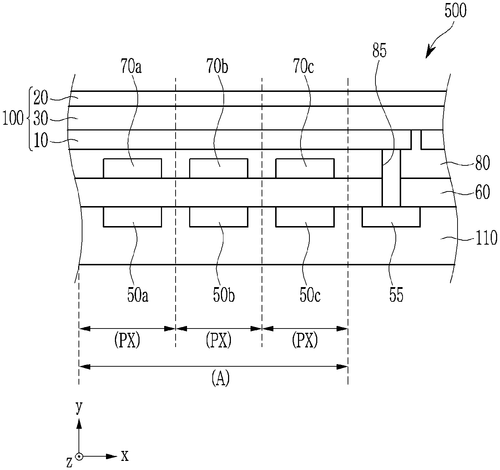
In a recently published patent, Samsung Electronics has disclosed a compound with potential applications in film, photoelectric diodes, organic sensors, and electronic devices. While the patent describes Chemical Formula 1, it remains uncertain whether this compound will move beyond the conceptual stage and be developed into a commercially viable product. The invention holds promise, particularly in the field of organic sensors and photoelectric diodes, where Samsung faces competition from industry giants such as Sony and LG. These companies have already made significant strides in developing innovative sensor technologies that are now being incorporated into various consumer electronics. However, it is important to note that patent filings alone do not guarantee the product's future implementation. Many patents remain unused or do not transition into tangible products due to various technical, financial, or marketing challenges. Hence, it's crucial to assess whether Samsung has the necessary resources, expertise, and market demand to bring this patent to life. If developed, the compound's potential applications in films and electronic devices could revolutionize the way we interact with technology. It might enable the creation of flexible displays, improved camera sensors, or advanced wearable devices. However, until we see concrete evidence of this patent materializing, it's too early to speculate on the actual impact it could have on the industry. So, while Samsung's latest patent certainly ignites excitement for tech enthusiasts like us, its future prospects will depend on whether the company can transform this idea into a genuinely disruptive product. Only time will tell. Readers, what are your thoughts on this Samsung patent? Are you optimistic about the potential applications of this compound, or do you think it will remain a concept on paper? Share your opinions and insights in the comments below.
Abstract
Disclosed are a compound represented by Chemical Formula 1, a film, a photoelectric diode, an organic sensor, and an electronic device. Disclosed are a compound represented by Chemical Formula 1, a film, a photoelectric diode, an organic sensor, and an electronic device.
US Patent 11858950
SAMSUNG ELECTRONICS CO., LTD.
"Samsung Introduces Innovative Tub Fixing Device for Enhanced Stability and Security"
What is this invention?
Tub fixing device and washing machine comprising the same
There once was a tub fixing device,
With a bolt and a washer precise,
A spacer in place,
With just the right space,
To keep things secure, oh how nice!
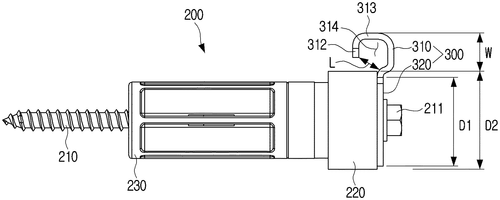
Samsung Electronics has recently filed a patent for a new tub fixing device, raising the intriguing possibility of an improvement in the world of bathroom technology. The device consists of a bolt that can be used to secure a tub, a metal washer with a unique design, and a spacer that limits the space between the washer and the cabinet to which the tub is fixed. Upon first glance, it may seem that this tub fixing device offers a practical and functional solution to the common problem of a loose or wobbly tub. The innovative design of the metal washer with its protruding hook region hints at an efficient and secure way to keep the tub firmly in place. However, it is important to note that a patent filing does not guarantee that the invention will enter the market as an actual product. With numerous competitor products already available, such as adhesive products or adjustable legs, it remains to be seen whether Samsung's tub fixing device will capture the attention of consumers and manufacturers alike. Still, one cannot help but speculate on the potential implications and uses of such a device. Would it not be remarkable to have a foolproof solution to prevent bathtubs from becoming unstable over time? Furthermore, it would be interesting to see if this device could be adapted for other applications, such as securing other household fixtures or even in commercial settings. In conclusion, Samsung's tub fixing device may offer a promising solution for a common household problem. However, only time will tell if this invention will ever see the light of day as a tangible product. As technology enthusiasts, we are left with an intriguing question: How would a device like this impact our daily lives, and could it revolutionize the way we think about tub stability? Share your thoughts and opinions in the comments below.
Abstract
A tub fixing device is disclosed. The tub fixing device includes a bolt configured to be fastened to a tub, a metal washer configured to have a washer region and a hook region protruded from the washer region, and a spacer configured to be disposed between a cabinet to which the tub is fixed and the washer to limit an open space of the hook region. A tub fixing device is disclosed. The tub fixing device includes a bolt configured to be fastened to a tub, a metal washer configured to have a washer region and a hook region protruded from the washer region, and a spacer configured to be disposed between a cabinet to which the tub is fixed and the washer to limit an open space of the hook region.
US Patent 11859331
SAMSUNG ELECTRONICS CO., LTD.
"Washing Machine Patent Revolutionizes Design with Fixing Bracket to Enhance Stability and Prevent Separation"
What is this invention?
Washing machine
In a washer of wondrous creation,
A bracket's brought separation cessation.
The fixing device
Holds the tubs precise,
No parting, no need for elation!
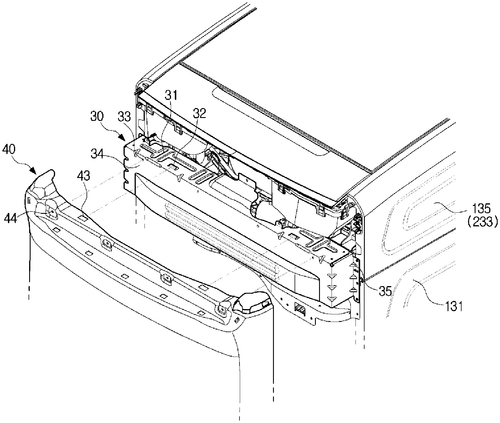
Samsung Electronics Co., Ltd. has recently filed a patent for a washing machine that certainly has the potential to revolutionize the way we do our laundry. The patent describes a washing machine with multiple washers, each contained within their own housing. What sets this proposed invention apart is the addition of a fixing bracket that would prevent the separate housings from being separated from each other. While this may not sound groundbreaking at first glance, it opens up a world of possibilities for efficiency and convenience in the laundry room. Imagine being able to wash multiple loads of laundry simultaneously, without the need for separate machines or having to wait for one load to finish before starting the next. Competitors in the washing machine market, such as LG and Whirlpool, have already introduced models with dual washers, but they are typically smaller units stacked on top of each other. Samsung's patent suggests a new approach, potentially providing a more intuitive user experience and easier access to each individual washer. The additional advantage of the fixing bracket is worth mentioning. It ensures stability and prevents any mishaps that could arise from the movement or separation of the individual housings. No more worrying about your washing machine wobbling or vibrating excessively during a cycle. As exciting as this patent sounds, it is important to note that not all patented inventions come to fruition as consumer products. Samsung has a history of innovative ideas that have transformed the tech landscape, but it remains to be seen if this particular washing machine concept will make it to production. What are your thoughts on this potential laundry game-changer? Would you find a washing machine with multiple individual washers useful in your household, or is it more of a novelty? Share your opinions in the comments below.
Abstract
A washing machine including a plurality of washers may include a fixing bracket coupled to a front of a first housing in which a first tub is disposed and a front of a second housing in which a second tub is disposed, to prevent the first housing and the second housing from being separated from each other. A washing machine including a plurality of washers may include a fixing bracket coupled to a front of a first housing in which a first tub is disposed and a front of a second housing in which a second tub is disposed, to prevent the first housing and the second housing from being separated from each other.
US Patent 11859332
SAMSUNG ELECTRONICS CO., LTD.
"Samsung's Innovative Washing Machine Patent Revolutionizes Shaft Support and Motor Coupling"
What is this invention?
Washing machine
In the heart of a washing machine,
A marvel of tech can be seen.
With bearing housing and leg plates,
It rotates, cleans, and agitates,
A revolution so smooth and serene.
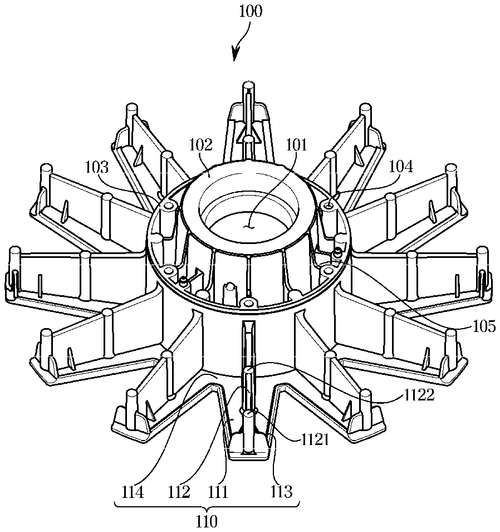
Samsung Electronics has recently filed a patent application for a new and improved washing machine design. The patent describes a washing machine that includes a bearing housing to support a shaft that drives the drum and can be inserted into the tub. What makes this design unique is the inclusion of a stator coupling portion, which allows for the attachment of a drive motor's stator to rotate the shaft. The bearing housing also features a set of leg portions that are evenly spaced around the stator coupling portion in a circular fashion. The leg portions are designed with a leg plate connected to the stator coupling portion at one end and extending radially along the stator coupling portion from this connection point. Adjacent leg portions are connected through a separate connection portion, forming a continuous structure. Additionally, a separation space is created between the second ends of the leg portions, adding further stability to the overall design. An outer rib is then formed along the edge of the leg plate and the connection portion, providing additional strength. While this patent application showcases a potentially innovative solution for washing machine designs, it is important to note that not all patented inventions make it to production. Samsung's competitors, such as LG and Whirlpool, have already established strong footholds in the washing machine market, offering their own innovative features and designs. It remains to be seen whether Samsung will bring this particular idea to market and how it will stack up against the competition. One possible use for this design could be in high-capacity washing machines used in commercial laundromats or large-scale industrial settings. The stability provided by the leg portions and the reinforced structure could be advantageous in handling heavy loads and ensuring smooth operation. Additionally, the separation space between the leg portions could potentially allow for better airflow, improving the cooling efficiency of the washing machine during prolonged use. As we eagerly await further developments from Samsung, we would love to hear your thoughts. Do you believe this patented washing machine design has the potential to shake up the market? Or do you think it may just end up as another concept that never makes it to production? Let us know in the comments below.
Abstract
A washing machine including a bearing housing to rotatably support a shaft configured to drive the drum and insertable into the tub, the bearing housing including a stator coupling portion to which a stator of a drive motor configured to rotate the shaft is coupled, and a plurality of leg portions spaced apart along a circumferential direction of the stator coupling portion. The plurality of leg portions include a leg plate including a first end connected to the stator coupling portion and a second end formed to extend along a radial direction of the stator coupling portion from the first end, a connection portion provided to connect between adjacent first ends of the plurality of leg portions, a separation space formed between second ends of the plurality of leg portions, and an outer rib formed along an edge of the leg plate and the connection portion. A washing machine including a bearing housing to rotatably support a shaft configured to drive the drum and insertable into the tub, the bearing housing including a stator coupling portion to which a stator of a drive motor configured to rotate the shaft is coupled, and a plurality of leg portions spaced apart along a circumferential direction of the stator coupling portion. The plurality of leg portions include a leg plate including a first end connected to the stator coupling portion and a second end formed to extend along a radial direction of the stator coupling portion from the first end, a connection portion provided to connect between adjacent first ends of the plurality of leg portions, a separation space formed between second ends of the plurality of leg portions, and an outer rib formed along an edge of the leg plate and the connection portion.
US Patent 11859334
Apple Inc.
"Apple Patents New Attachment System for Wearable Electronic Devices"
What is this invention?
Attachment systems for electronic devices
An attachment system that's neat,
For wearables, it's quite a feat,
With sizing and retaining band,
In eyelet, the plug will stand,
Resisting separation, complete!
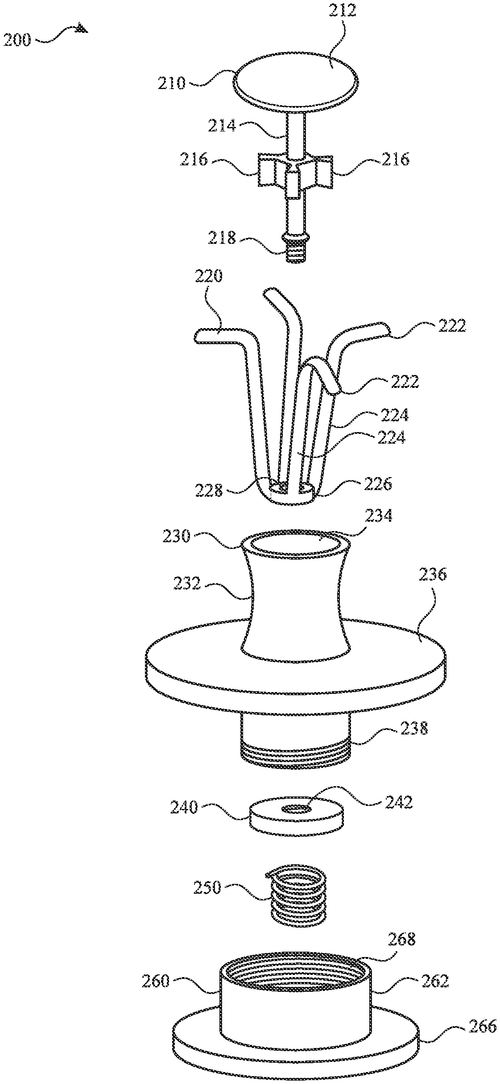
In a recently published patent, tech giant Apple Inc. has detailed its latest invention—an attachment system for wearable electronic devices. The system features a sizing band and a retaining band, providing a secure and comfortable fit for users. The retaining band further incorporates a plug assembly, such as an actuatable button or retractable arms, designed to be inserted into an eyelet on the sizing band. By inserting the plug assembly into the selected eyelet, the attachment system effectively prevents any unintended separation between the sizing and retaining bands. This is achieved by increasing the outer dimension of the plug assembly, ensuring a tight connection. When it comes time to remove the wearable device, the user can easily decrease the outer dimension of the plug assembly, allowing for a simple and effortless release from the eyelet. While this patent showcases Apple's continuous commitment to innovation in the wearable technology space, it's essential to remember that not all patented inventions make it into actual, tangible products. Competitors in the wearables market, such as Fitbit and Samsung, already offer their own attachment systems with varying features and functionalities. If brought to market, Apple's attachment system could potentially enhance the user experience by providing a reliable and customizable fit for their wearable devices. One can imagine athletes benefitting from this technology during rigorous workouts, or individuals with different wrist sizes enjoying a secure and comfortable fit throughout the day. As always, questions arise regarding the practicality and feasibility of such inventions. How comfortable would the sizing band be for extended wear? Would the plug assembly be prone to accidental release? What other applications could this attachment system have beyond wearable devices? Let us know your thoughts in the comment section below.
Abstract
Attachment systems for attaching a wearable electronic device to a user including a sizing band and a retaining band are disclosed. The retaining band can include a plug assembly (e.g., actuatable button, retractable arms, etc.) configured to be inserted in a selected eyelet of the sizing band. Upon insertion into the eyelet, the plug assembly can resist unintended separation of the sizing and retaining band by increasing its outer dimension. Release can be achieved by allowing the user to decrease the outer dimension of the plug assembly so that removal from the selected eyelet is easily achieved. Attachment systems for attaching a wearable electronic device to a user including a sizing band and a retaining band are disclosed. The retaining band can include a plug assembly (e.g., actuatable button, retractable arms, etc.) configured to be inserted in a selected eyelet of the sizing band. Upon insertion into the eyelet, the plug assembly can resist unintended separation of the sizing and retaining band by increasing its outer dimension. Release can be achieved by allowing the user to decrease the outer dimension of the plug assembly so that removal from the selected eyelet is easily achieved.
US Patent 11857031
Apple Inc.
"Apple Patents Wearable Device that Detects Proximity to Human Tissue"
What is this invention?
Devices having matter differentiation detectors
There's a wearable device, so neat,
With emitters and a photodetector to cheat,
It emits beams of radiation,
Different wavelengths in rotation,
Helping differentiate what it meets.
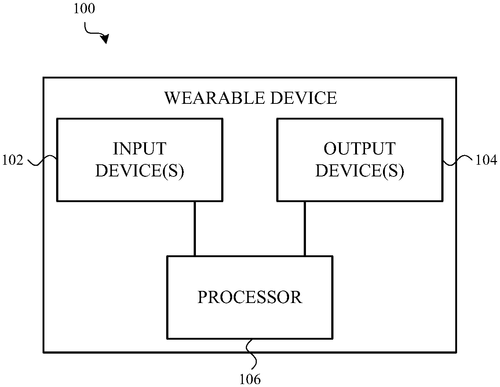
Apple Inc. has recently filed a patent for an intriguing wearable device that could have significant implications for the future of health monitoring technology. The patent describes a device featuring a wrist band attached to a housing, within which are positioned first and second emitters capable of emitting beams of electromagnetic radiation at different infrared (IR) wavelengths. Additionally, a photodetector and a matter differentiation circuit are included, enabling the device to indicate whether the back of the housing is likely in contact with human tissue. On the surface, this patent suggests that Apple is exploring the possibility of incorporating advanced biometric sensors into its future wearable products. By emitting different IR wavelengths and analyzing the reflected radiation, the device could potentially identify and differentiate between various types of matter, such as surrounding environment and human tissue. While the patent provides no specific details regarding the intended purpose of this technology, one can speculate about its potential applications. Health monitoring seems to be the most feasible use case for this device. It could provide valuable insights into a wearer's physical condition and vital signs by detecting whether it is in contact with the user's skin or another surface. For example, this technology could be harnessed to accurately measure heart rate, blood oxygen levels, or even to detect skin diseases. As the wearable tech market rapidly evolves, the integration of such advanced sensors would undoubtedly be a significant advancement. However, it is essential to approach this patent with a pragmatic lens. Patents do not necessarily indicate that a product will come to fruition, and many never make it to the mass market. Apple has a history of filing patents that showcase exciting ideas but never materialize into actual consumer products. It remains to be seen whether this particular wearable device will make its way into the hands of consumers. Nevertheless, the potential implications and applications of this patented technology are indeed intriguing. How do you envision this advanced matter differentiation technology being used in a wearable device? Can you think of any other industries or fields that could benefit from this innovation? Share your thoughts and ideas in the comments below.
Abstract
A wearable device includes a housing; a wrist band attached to the housing; first and second emitters positioned within the housing and configured to respectively emit, through a back of the housing, a first beam of electromagnetic radiation having a first infrared (IR) wavelength and a second beam of electromagnetic radiation having a second IR wavelength. The second IR wavelength is different from the first IR wavelength. The wearable device also includes a photodetector positioned within the housing and filtered to detect a set of electromagnetic radiation wavelengths including the first IR wavelength and the second IR wavelength; and a matter differentiation circuit configured to indicate, at least partly in response to signals indicating amounts of the first IR wavelength and the second IR wavelength received by the photodetector, whether the back of the housing is likely proximate to human tissue. A wearable device includes a housing; a wrist band attached to the housing; first and second emitters positioned within the housing and configured to respectively emit, through a back of the housing, a first beam of electromagnetic radiation having a first infrared (IR) wavelength and a second beam of electromagnetic radiation having a second IR wavelength. The second IR wavelength is different from the first IR wavelength. The wearable device also includes a photodetector positioned within the housing and filtered to detect a set of electromagnetic radiation wavelengths including the first IR wavelength and the second IR wavelength; and a matter differentiation circuit configured to indicate, at least partly in response to signals indicating amounts of the first IR wavelength and the second IR wavelength received by the photodetector, whether the back of the housing is likely proximate to human tissue.
US Patent 11857298
Apple Inc.
"Apple's Latest Patent Reveals Revolutionary Watch with Built-in Electrodes for Advanced Physiological Measurements"
What is this invention?
Watch having electrodes for physiological measurements
There once was a watch so smart,
With electrodes to measure the heart.
It had a wristband connection,
And to the wrist it gave protection,
Obtaining vital stats was its art.
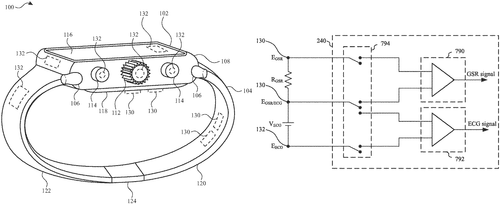
Apple Inc. has recently been granted a patent for a watch that aims to take wearable technology to the next level. This invention promises to incorporate electrodes into a wristwatch for measuring various physiological parameters. The watch design features an enclosure that can be attached to a wristband, and it includes an electrode for capturing these measurements. With processing circuitry housed in the enclosure, the electrode can be utilized to gather multiple types of physiological data. While the idea of a smartwatch capable of monitoring our health is not entirely new, Apple's patent brings a fresh perspective to the concept. With the inclusion of electrodes, this watch has the potential to enhance the accuracy and range of health data collected. Such information could include heart rate, blood oxygen levels, and even electrocardiograms. The wearable tech market has seen a surge of interest in health monitoring devices over the past few years, with competitors such as Fitbit, Garmin, and Samsung already offering similar features. Apple's patent, if brought to market, could further refine and elevate the capabilities of these devices, setting a new standard for health monitoring in the smartwatch industry. Looking ahead, one can imagine various potential applications for this innovative watch design. For athletes, it could provide real-time data during workouts to optimize training routines. Individuals with pre-existing health conditions may find it particularly useful for monitoring their vitals on a daily basis, aiding in early detection of any abnormalities. Moreover, these watches could potentially integrate with other health apps and devices, creating a holistic approach to personal health management. However, it is crucial to remember that not every patented technology eventually makes it to the consumer market. Although Apple's watch with electrodes seems promising, actual product development and commercialization are separate challenges. There are numerous factors to consider, including manufacturing costs, user adaptability, and regulatory approvals. So, readers, with the growing interest in wearable health tech, what are your thoughts on this potential advancement? Would you find a watch with built-in electrodes useful, or do you have concerns about the accuracy and reliability of such a device? Share your opinions and insights in the comments below.
Abstract
A watch having electrodes for physiological measurements is disclosed. The watch can be provided with an enclosure configured to couple to a wristband. An electrode can be disposed on the enclosure. Processing circuitry can be disposed in the enclosure and configured to use the electrode to obtain multiple types of physiological measurements. A watch having electrodes for physiological measurements is disclosed. The watch can be provided with an enclosure configured to couple to a wristband. An electrode can be disposed on the enclosure. Processing circuitry can be disposed in the enclosure and configured to use the electrode to obtain multiple types of physiological measurements.
US Patent 11857340
Apple Inc.
"Apple's Latest Patent Revolutionizes ECG Signal Filtering with Mobile and Wearable Devices"
What is this invention?
Systems and methods of spatial filtering for measuring electrical signals
In the world of wearables, advanced tech,
ECG signals, we now detect.
With an electrode array,
And a controller in play,
Filtering noise, our hearts we protect.
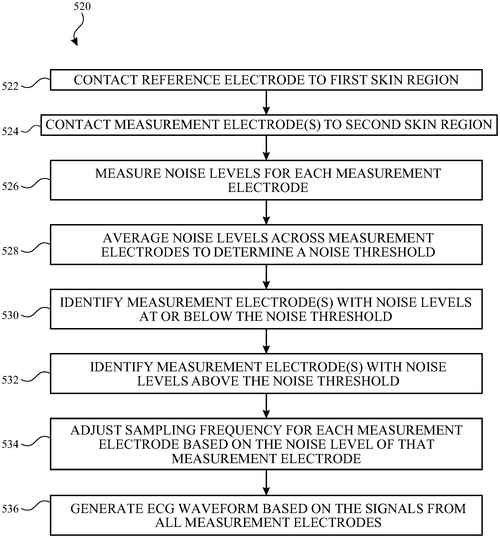
Apple Inc. has recently disclosed a patent that introduces a new way of using mobile or wearable devices for the acquisition and spatial filtering of ECG signals from an electrode array. The patent describes a variation of a device that includes an array of electrodes, one or more reference electrodes, and a controller in communication with the electrodes. One interesting aspect is that the reference electrodes are located on a wrist-worn device, such as a watch, while the electrode array is located on an accessory device that can be contacted with a fingertip. This innovative approach allows for the identification and filtering of ECG signals in different ways. One method involves excluding the ECG signals from electrodes that exhibit high levels of noise, while another method involves including only the ECG signals from electrodes with low levels of noise in further analyses. By filtering out noise, these techniques aim to improve the accuracy and quality of ECG measurements obtained from the device. While Apple's patent seems promising, it is important to note that patents are not always indicative of future product releases. Many patents are filed to protect intellectual property and may never materialize as actual consumer products. As such, it remains to be seen whether this technology will make its way into an actual Apple product. Competitors in the wearable technology market, such as Fitbit and Garmin, already offer ECG capabilities in some of their devices. Apple's proposed approach could potentially enhance the accuracy and reliability of ECG measurements, providing a competitive edge in this growing market segment. Imagining the potential uses for this technology, it could be a valuable tool for individuals who monitor their heart health regularly or have existing heart conditions. It could also be integrated into various healthcare and fitness applications, allowing users to track their heart rate and detect potential irregularities conveniently and reliably. As we await further developments from Apple regarding this patent, it would be interesting to hear from readers about their opinion on ECG monitoring devices. Do you find such technology valuable for your personal health and wellness? How would you envision using it in your daily life? Share your thoughts in the comments below.
Abstract
Disclosed herein are devices and methods of using a mobile or wearable device for the acquisition and spatial filtering of ECG signals from an electrode array. One variation of a mobile or wearable device comprises an array of electrodes, one or more reference electrodes, and a controller in communication with the electrodes. In one example, the one or more reference electrodes are located on a wrist-worn device (e.g., a watch), and the electrode array is located on an accessory device that may be contacted with a fingertip. One variation of a spatial filtering method comprises identifying the electrodes that have high levels of noise and excluding the ECG signals from those electrodes from further analyses. In another variation, a method of spatial filtering comprises identifying electrodes with low levels of noise and including only the ECG signals from those electrodes in further analyses. Disclosed herein are devices and methods of using a mobile or wearable device for the acquisition and spatial filtering of ECG signals from an electrode array. One variation of a mobile or wearable device comprises an array of electrodes, one or more reference electrodes, and a controller in communication with the electrodes. In one example, the one or more reference electrodes are located on a wrist-worn device (e.g., a watch), and the electrode array is located on an accessory device that may be contacted with a fingertip. One variation of a spatial filtering method comprises identifying the electrodes that have high levels of noise and excluding the ECG signals from those electrodes from further analyses. In another variation, a method of spatial filtering comprises identifying electrodes with low levels of noise and including only the ECG signals from those electrodes in further analyses.
US Patent 11857341
Amazon Technologies, Inc.
"Amazon's New Patent Revolutionizes Robotic Manipulation and Object Transportation"
What is this invention?
Robotic manipulator systems and methods involving non-planar and/or deformable support structures
In the realm of robotics we delve,
A system to manipulate and excel.
With a controller in tow,
The support structure will show,
Grasping objects like a robotic spell!
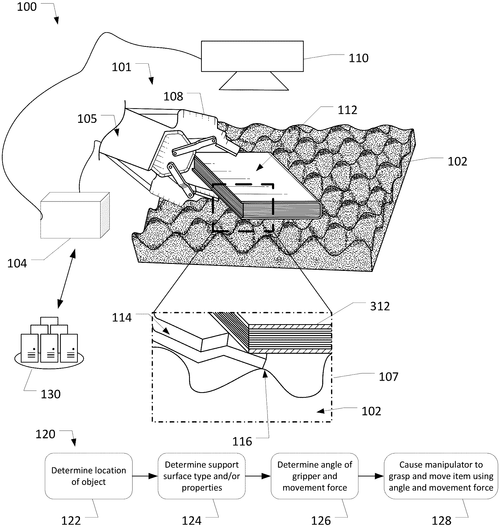
Amazon Technologies, Inc. has recently filed a patent for an intriguing new robotic manipulator system. The system includes a robotic manipulator, a controller, one or more sensors, and a deformable support structure. According to the patent, the support structure is designed to hold objects on its upper surface and can take on various non-planar shapes. One notable aspect of this system is the inclusion of sensors that are directed towards the support structure and the object it is holding. This allows the controller, along with other computing devices, to determine the geometry and compression value of the support structure. With this information, the controller can instruct the robotic manipulator to grasp the object and move it to a new location. The potential applications for such a system are vast. It could revolutionize the logistics industry, enabling efficient and automated handling of various goods. Additionally, in manufacturing settings, the robotic manipulator system could enhance productivity and precision by reliably manipulating objects in complex environments. While this patent is certainly intriguing, it is important to note that not all patented inventions make it to market. Many factors, such as feasibility, cost-effectiveness, and competition from existing products, influence the commercialization process. In this regard, it will be interesting to see how Amazon Technologies, Inc. develops this robotic manipulator system, especially considering the fierce competition in the robotics industry. Do you think this new robotic manipulator system has the potential to succeed in the market? How do you imagine it could be utilized in various industries? Share your thoughts in the comments below!
Abstract
Systems, methods, and systems are disclosed for a robotic manipulator system including a robotic manipulator, a controller, one or more sensors, and a support structure. The support structure may be non-planar and/or deformable and may be designed to support an object on an upper surface. The one or more sensors may be directed towards the support structure and object. The controller and/or another computing device in communication with the controller may determine geometry of the support structure and may know or determine a compression value of the support structure. Using the compression value and/or geometry of the support structure, the controller may cause the robotic manipulator to grasp the object from the support structure and move the object to a new location. Systems, methods, and systems are disclosed for a robotic manipulator system including a robotic manipulator, a controller, one or more sensors, and a support structure. The support structure may be non-planar and/or deformable and may be designed to support an object on an upper surface. The one or more sensors may be directed towards the support structure and object. The controller and/or another computing device in communication with the controller may determine geometry of the support structure and may know or determine a compression value of the support structure. Using the compression value and/or geometry of the support structure, the controller may cause the robotic manipulator to grasp the object from the support structure and move the object to a new location.
US Patent 11858139
Amazon Technologies, Inc.
"Amazon's New Patent Allows for Lightweight and Customizable Components Using Thermally Expanding Mandrels"
What is this invention?
Thermally expanding mandrel for cast components
Inventing with advanced technique,
Components with shape quite unique.
With thermally expanding,
And skilled molding commanding,
Creating strength that's at its peak.
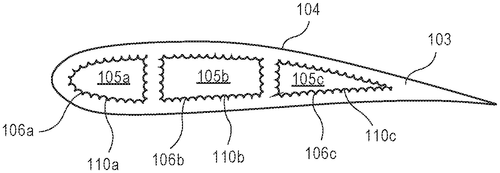
New Invention Promises Lightweight and Strong ComponentsAm. azon Technologies, Inc. has recently patented a groundbreaking process for manufacturing lightweight and sturdy components. The patent describes the use of thermally expanding mandrels to create components with any desired shape or form. By utilizing expanding material composition and a water-soluble binder, such as gypsum plaster, the mandrels can be effortlessly removed after the formation of the component. This innovative technique offers immense potential in numerous fields. The ability to manufacture lightweight and strong components with various geometries opens up possibilities in areas such as aerospace, automotive, and construction industries. The process seems particularly promising for applications where weight reduction is crucial, as it could contribute to fuel savings and increased efficiency. While the patent demonstrates a truly fascinating concept, one cannot help but wonder about the practicality of this technology in the real world. Will Amazon Technologies, Inc. be able to bring this invention to market? And if so, how viable will it prove to be against existing and emerging alternatives? Despite this skepticism, the potential advantages of this technique cannot be denied. Its potential to revolutionize manufacturing processes and improve product performance make it an exciting prospect for numerous industries. If successfully implemented, companies like Boeing or SpaceX could potentially adopt this technology, leading to new advancements in aerospace engineering. Meanwhile, automotive manufacturers may use it to create lighter and more fuel-efficient vehicles. As we eagerly await the future developments, we invite you, our readers, to share your thoughts. Would you welcome such a technology in your industry? Can you envision other potential applications that this patent might enable? Let us know in the comments below.
Abstract
Lightweight and strong components having any desired shape, form, or geometry may be manufactured using thermally expanding mandrels by the processes described herein. A thermally expanding mandrel may be formed from an expanding material composition including thermally expanding particles, e.g., micronized rubber particles, and water-soluble binder material, e.g., gypsum plaster. Component material may be applied to the mandrel, and the mandrel may be inserted into a molding tool. Upon application of heat to the mandrel, the mandrel may expand, and compress and cure the component material into a component within the molding tool. Following formation of the component, the mandrel may be washed out of the component, e.g., using pressurized water, and the expanding material composition may be recycled and/or reused. Lightweight and strong components having any desired shape, form, or geometry may be manufactured using thermally expanding mandrels by the processes described herein. A thermally expanding mandrel may be formed from an expanding material composition including thermally expanding particles, e.g., micronized rubber particles, and water-soluble binder material, e.g., gypsum plaster. Component material may be applied to the mandrel, and the mandrel may be inserted into a molding tool. Upon application of heat to the mandrel, the mandrel may expand, and compress and cure the component material into a component within the molding tool. Following formation of the component, the mandrel may be washed out of the component, e.g., using pressurized water, and the expanding material composition may be recycled and/or reused.
US Patent 11858179
Amazon Technologies, Inc.
"Amazon Patent Reveals Aerial Vehicle Using Propeller Noise to Detect Objects in Surroundings"
What is this invention?
Object detection using propeller noise
In the sky, an aerial vehicle flies,
Using propeller noise as the prize.
Reflecting on objects,
Detecting the prospects,
Distance and direction, it spies.
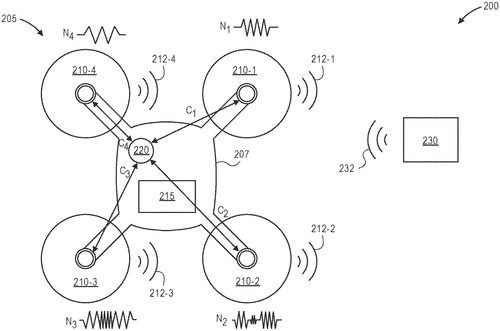
Amazon Technologies, Inc. recently filed a patent that unveils an intriguing new system for object detection by aerial vehicles. The patent describes a method for an aerial vehicle to detect objects in its environment by analyzing the propeller noises it emits and receives back from the objects. According to the patent, the propeller noise generated during the regular operation of one or more propellers propagates into the surroundings and bounces off any objects in its path. By analyzing these reflected noises, the aerial vehicle can compute sets of solutions representing the distance and direction of detected objects. The intersections of these sets then provide an accurate representation of the object's actual distance and direction with respect to the aerial vehicle. The potential applications for this technology are vast. Imagine a delivery drone autonomously avoiding obstacles in real-time or a surveillance drone detecting and tracking intruders within a restricted area. The use of noise analysis for object detection could greatly enhance the safety and performance of aerial vehicles in a multitude of scenarios. While this patent by Amazon Technologies is undoubtedly fascinating, it's important to note that just because a company files a patent does not guarantee that the invention will make it to market. It is also worth considering that competitors such as DJI, a leading drone manufacturer, already offer similar obstacle avoidance systems in their consumer products. Nonetheless, this patent is a testament to the ever-evolving world of drone technology. As the use of aerial vehicles continues to expand, innovative solutions like Amazon's noise-based object detection could become an integral part of future drone designs. What are your thoughts on this noise-based object detection system for drones? Do you believe it has the potential to revolutionize the industry? Let us know in the comments below.
Abstract
Disclosed are systems and methods to detect objects within an environment by an aerial vehicle. An aerial vehicle may detect objects within an environment based on propeller noises emitted by the aerial vehicle that are reflected back to the aerial vehicle by objects in the environment. The propeller noise may be noise that is generated during normal operation of one or more propellers. The propeller noise emitted by the propellers of the aerial vehicle propagates into the environment around the aerial vehicle and reflects off any objects within the environment. Because the noise generated by each propeller is distinguishable, sets of solutions (distance and all directions) may be computed for each propeller. The intersections of those sets of solutions is representative of the actual distance and direction of the object with respect to the aerial vehicle. Disclosed are systems and methods to detect objects within an environment by an aerial vehicle. An aerial vehicle may detect objects within an environment based on propeller noises emitted by the aerial vehicle that are reflected back to the aerial vehicle by objects in the environment. The propeller noise may be noise that is generated during normal operation of one or more propellers. The propeller noise emitted by the propellers of the aerial vehicle propagates into the environment around the aerial vehicle and reflects off any objects within the environment. Because the noise generated by each propeller is distinguishable, sets of solutions (distance and all directions) may be computed for each propeller. The intersections of those sets of solutions is representative of the actual distance and direction of the object with respect to the aerial vehicle.
US Patent 11858625
Amazon Technologies, Inc.
"Amazon's Innovative Patent Revolutionizes Satellite Dispensing in Launch Vehicles"
What is this invention?
Satellite dispenser
In the sky, a launch vehicle soars,
Dispensing satellites in scores.
With circular rings,
And vertical springs,
It releases them through sturdy doors.
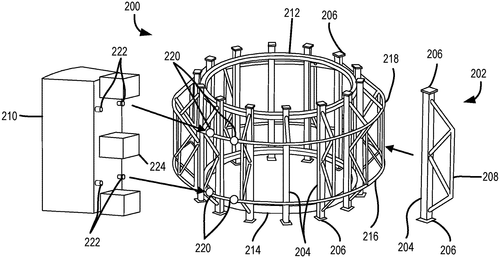
Amazon Technologies, Inc. has recently patented a new system for satellite dispensing from the second stage of a launch vehicle. Although the patent describes the technology in detail, it's important to note that there is no guarantee this invention will actually be turned into a tangible product anytime soon. The patent outlines a satellite dispenser ring consisting of a circular ring, a vertical stanchion, and a truss. The vertical stanchion is designed to connect with an adjacent satellite dispenser ring and is also attached to the perimeter of the circular ring, perpendicular to its plane. The patent further explains the inclusion of a satellite attachment interface located at the edge of the vertical stanchions, which allows for the coupling and release of a satellite. While this innovation showcases the continuous advancements made in satellite technology, it is crucial to recognize that patents do not always translate into viable products. Many patents serve as a means to protect concepts or ideas, and it remains to be seen whether Amazon Technologies will further develop and implement this satellite dispensing system. Competitors in the satellite industry, such as SpaceX and OneWe. b, have already made significant progress in satellite deployment methods. SpaceX's Starlink network, for example, utilizes a deployment mechanism wherein the satellites are stacked and released by their Falcon 9 rockets. OneWe. b, on the other hand, employs a simplified and automated approach to launch multiple satellites simultaneously. If Amazon Technologies were able to successfully bring this patent to life, potential applications for their satellite dispenser system could include deploying a constellation of communication satellites for global internet coverage or facilitating rapid replacement and repositioning of satellites for Earth observation purposes. In light of this patent's description, it would be interesting to hear readers' thoughts on the future of satellite deployment technologies. Do you believe this innovation has the potential to revolutionize the satellite industry? How would you envision the commercialization of such a satellite dispenser system? Share your insights in the comments below.
Abstract
Systems for satellite dispensing from a second stage of a launch vehicle are described. In an example, a satellite dispenser ring includes a circular ring, a vertical stanchion, and a truss. The vertical stanchion has an interface to couple with an adjacent satellite dispenser ring. The vertical ring is also coupled to a perimeter of the circular ring perpendicular to a place of the circular ring. A satellite attachment interface at an edge of the vertical stanchions couples and releases a satellite. Systems for satellite dispensing from a second stage of a launch vehicle are described. In an example, a satellite dispenser ring includes a circular ring, a vertical stanchion, and a truss. The vertical stanchion has an interface to couple with an adjacent satellite dispenser ring. The vertical ring is also coupled to a perimeter of the circular ring perpendicular to a place of the circular ring. A satellite attachment interface at an edge of the vertical stanchions couples and releases a satellite.
US Patent 11858667
Amazon Technologies, Inc.
"Amazon's Innovative Robotic System Utilizes Range Sensors to Create Accurate Vector Maps of Warehouses"
What is this invention?
Physical models for hierarchical clustering and symbolic inference
In a world of tech, so bold and grand,
A robotic system takes command,
Range sensors identify,
Objects with lines that imply,
Errors merged, a vector map so planned.
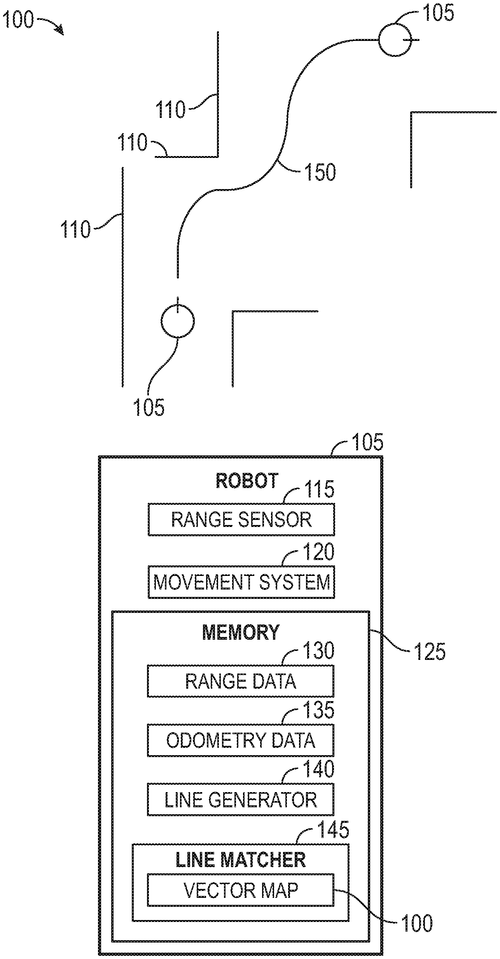
Amazon Technologies, Inc. has recently patented a robotic system that aims to improve the accuracy of object recognition in environments such as warehouses. The system utilizes range sensors to create a vector map of the surrounding area, outlining the shape of various objects, such as shelves. By utilizing range data acquired by the range sensors, the system identifies line segments that represent the boundaries of these objects. However, due to potential errors and inaccuracies, the line segments formed at different locations may not align perfectly, even when they correspond to the same object. To tackle this issue, the robotic system employs a process of matching line segments identified at one location with those identified at another. These matched line segments are then merged into a single line, which is stored in the vector map. On the surface, this patent suggests exciting potential for improving the efficiency of tasks within warehouse environments. The ability to accurately identify and map objects using range sensors offers potential benefits such as optimized inventory management and navigation for robotic systems. However, it is important to note that while a patent has been granted, it does not guarantee that this technology will actually be developed into a marketable product. Patent applications often represent early-stage ideas and may not necessarily translate into commercial inventions. Furthermore, while Amazon's patent details the potential use of this technology in warehouses, it remains to be seen how it would compare to existing competitor's products in terms of accuracy, reliability, and cost-effectiveness. In conclusion, while Amazon's patent for a robotic system utilizing range sensors to improve object identification in warehouse environments appears promising, it is important to approach this development with a mixture of excitement and practicality. Will this technology revolutionize warehouse operations or simply become another interesting idea locked away in a patent? Only time will tell. What potential applications do you envision for this robotic system beyond the warehouse environment? Share your thoughts in the comments below.
Abstract
Embodiments herein describe a robotic system that uses range sensors to identify a vector map of an environment. The vector map includes lines that outline the shape of objects in the environment (e.g., shelves on the floor of a warehouse). The system identifies one or more line segments representing the boundary or outline of the objects in the environment using range data acquired by the range sensors. The robotic system can repeat this process at different locations as it moves in the environment. Because of errors and inaccuracies, line segments formed at different locations may not clearly align even when these line segments correspond to the same object. To account for this error, the robotic system match line segments identified at a first location with line segments identified at a second location. The matched line segments can be merged into a line that is stored in the vector map. Embodiments herein describe a robotic system that uses range sensors to identify a vector map of an environment. The vector map includes lines that outline the shape of objects in the environment (e.g., shelves on the floor of a warehouse). The system identifies one or more line segments representing the boundary or outline of the objects in the environment using range data acquired by the range sensors. The robotic system can repeat this process at different locations as it moves in the environment. Because of errors and inaccuracies, line segments formed at different locations may not clearly align even when these line segments correspond to the same object. To account for this error, the robotic system match line segments identified at a first location with line segments identified at a second location. The matched line segments can be merged into a line that is stored in the vector map.
US Patent 11860278
Micron Technology, Inc.
"New Patent Revolutionizes Error Notification in Memory Systems Using External Channels"
What is this invention?
Error notification using an external channel
In systems with a logical block,
Errors can make the memory rock.
Using external channels,
Notifications, like annals,
Keep hosts informed round the clock.
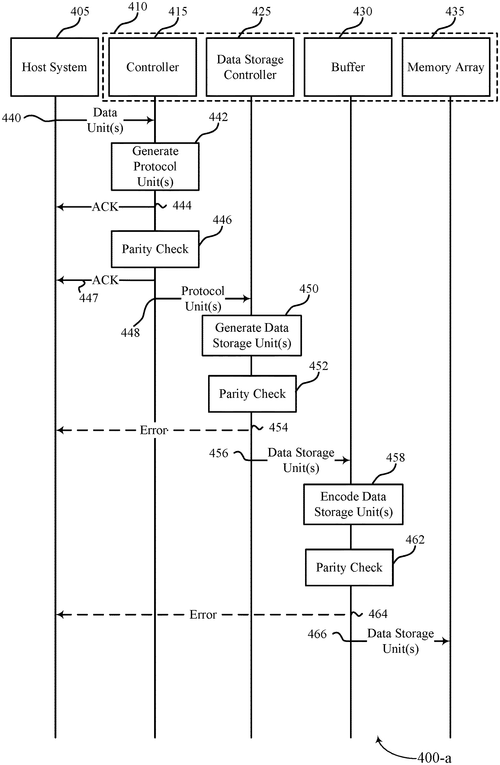
In a recent patent application, Micron Technology, Inc. has described methods, systems, and devices for error notification using an external channel. This innovation could potentially revolutionize the way memory systems handle error detection and communication, providing a more efficient and reliable solution. The patent outlines a memory system with a host-driven logical block interface that is capable of notifying the host system of any detected errors using an out-of-band channel. This means that, before storing data received from the host system, the memory system can send an acknowledgment to indicate successful reception. The data is then transferred through various components within the memory system, with parity checks performed at each stage. If an error is detected along the data path, the memory system can then promptly send a notification to the host system via the out-of-band channel. This invention has the potential to greatly enhance the reliability and performance of memory systems, as it allows for real-time error detection and prompt communication, leading to quicker resolutions. By leveraging an external channel for error notification, the memory system can ensure that any potential issues are addressed promptly, potentially preventing data loss or other IT complications. While the patent application shows promise in terms of its technological innovation, it is important to note that not all patented inventions make it to the market. Competitor products, such as Error Correcting Codes (ECC), already exist and provide similar error detection capabilities. Hence, the practical implementation of this patent could face challenges in terms of market adoption and integration. In terms of potential uses, this error notification system could have significant implications for industries and applications that heavily rely on memory systems, such as data centers, cloud computing, and high-performance computing. It could foster more efficient data management practices and reduce the risk of critical errors. Considering the competitive landscape and the potential benefits, the question arises: Will Micron Technology, Inc. be able to bring this error notification system to market and garner widespread adoption? What are your thoughts on the significance and practicality of implementing such an innovation in memory systems? Share your insights in the comments below.
Abstract
Methods, systems, and devices for error notification using an external channel are described. In some cases, a memory system having a host-driven logical block interface may issue a notification of a detected error using an out of band channel. For example, after receiving a data unit from a host system but prior to storing the data in a memory array of the memory system, the memory system may transmit an acknowledgment to host system to indicate that the data was successfully received. As part of storing the data, the memory system may transfer the data along data paths between various components and perform parity checks at each component. If the memory system detects an error along a data path, the memory system may issue a notification of the error to the host system over the out of band channel. Methods, systems, and devices for error notification using an external channel are described. In some cases, a memory system having a host-driven logical block interface may issue a notification of a detected error using an out of band channel. For example, after receiving a data unit from a host system but prior to storing the data in a memory array of the memory system, the memory system may transmit an acknowledgment to host system to indicate that the data was successfully received. As part of storing the data, the memory system may transfer the data along data paths between various components and perform parity checks at each component. If the memory system detects an error along a data path, the memory system may issue a notification of the error to the host system over the out of band channel.
US Patent 11860714
Micron Technology, Inc.
"New Patent Allows for Efficient Memory Programming and Redundancy Metadata Storage"
What is this invention?
Redundancy metadata media management at a memory sub-system
In the realm of memory sub-system,
A request comes to program and run.
With logical address and host data in hand,
Redundancy factor we understand.
And store it all in cells, second to none.
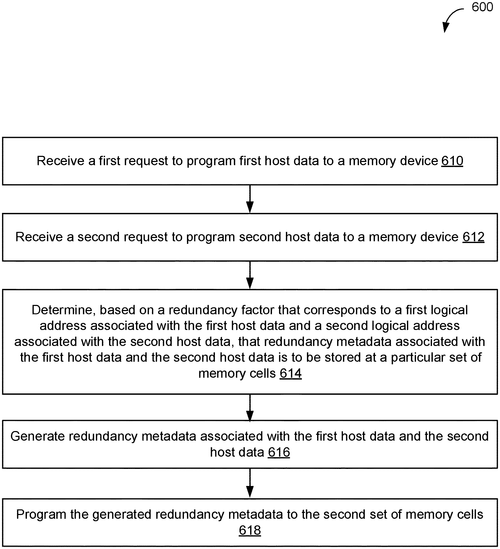
In a recent patent application from Micron Technology, Inc., an interesting approach to programming data in memory devices has been described. The invention aims to efficiently store and manage data using logical and physical addresses, along with redundancy metadata. When a request is received to program host data in a memory device, the system associates the data with a logical address and obtains a corresponding redundancy factor. Based on this factor, the invention proceeds to determine two physical addresses – one for the memory cells to store the host data and another for the memory cells to store redundancy metadata. The first set of memory cells stores the actual host data, while the second set of cells is dedicated to storing redundancy metadata associated with that data. This innovative approach allows for a more organized and optimized storage system, ensuring data integrity and efficient retrieval. While the patent application highlights the potential benefits of this technology, it's important to remember that not all patented ideas turn into actual products. Micron Technology faces competition from other memory device manufacturers, who may already have their own methods in place. Additionally, the implementation and scalability of this approach need to be thoroughly tested before it can be deemed practical for commercial use. In terms of potential applications, this new approach to programming memory devices could have a wide range of uses. In sectors that rely heavily on data storage, such as cloud computing, artificial intelligence, or Internet of Things devices, efficient and reliable memory management is crucial. Micron's invention, if proven effective, could provide a significant advantage in these areas. The question remains: Will Micron Technology successfully bring this patent to life and revolutionize the memory device industry? What are your thoughts on this innovative approach to programming data? Let us know in the comments below.
Abstract
A request is received to program host data to a memory device of a memory sub-system. The host data is associated with a logical address. A redundancy factor that corresponds to the logical address associated with the host data is obtained. A first physical address associated with a first set of cells of the memory device and a second physical address associated with a second set of cells of the memory device are determined based on the redundancy factor. The first set of memory cells is to store the host data and the second set of memory cells is to store redundancy metadata associated with the host data. The host data is programmed to the first set of memory cells. The redundancy metadata associated with the host data is programmed to the second set of memory cells. A request is received to program host data to a memory device of a memory sub-system. The host data is associated with a logical address. A redundancy factor that corresponds to the logical address associated with the host data is obtained. A first physical address associated with a first set of cells of the memory device and a second physical address associated with a second set of cells of the memory device are determined based on the redundancy factor. The first set of memory cells is to store the host data and the second set of memory cells is to store redundancy metadata associated with the host data. The host data is programmed to the first set of memory cells. The redundancy metadata associated with the host data is programmed to the second set of memory cells.
US Patent 11860732
Micron Technology, Inc.
"New Patent Allows for Efficient Monitoring of Memory Access Statistics"
What is this invention?
Memory access statistics monitoring
In a world of memory access,
Monitoring, a brand new process.
Hosts mapping pages, oh what a feat,
To memory devices, they're sweet.
Optimizing performance, the host does impress!
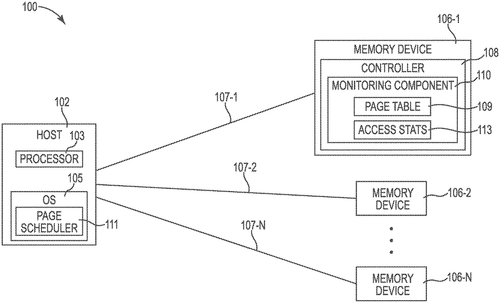
Micron Technology, Inc. has recently filed a patent that describes systems, apparatuses, and methods related to memory access statistics monitoring. In simple terms, this patent focuses on how a computer system can efficiently track and monitor the usage of memory in different devices. According to the patent, a host (the main computer or server) is designed to allocate memory pages to multiple memory devices. One of these memory devices, the first memory device, includes a component specifically designed for tracking and monitoring access statistics of the memory pages allocated to it. On the other hand, the second memory device lacks this monitoring component. Interestingly, the patent implies that despite having available space on the second memory device, the host will intentionally allocate a portion of memory pages for applications to the first memory device. This way, the host can obtain access statistics corresponding to these specific memory pages when the applications are executed. It is then suggested that the mapped memory pages can be adjusted based on the obtained access statistics. While this patent presents an intriguing concept, it is important to note that patents do not always materialize into actual products. Additionally, it is worth considering how this invention would fare in the competitive market. Companies such as Samsung and Intel already have robust offerings in the memory space, and it remains to be seen if this patent brings enough innovation to differentiate itself from existing solutions. Nevertheless, if implemented successfully, this technology could have potential applications in optimizing memory allocation and performance in computer systems. It could help identify which memory pages are accessed more frequently, allowing for more efficient resource allocation and potentially improving overall system performance. As the industry strives for more efficient memory management techniques, this patent raises the question: How vital is memory access statistics monitoring in computer systems, and what potential benefits or drawbacks do you foresee in implementing such a solution? Leave your thoughts in the comments below!
Abstract
Systems, apparatuses, and methods related to memory access statistics monitoring are described. A host is configured to map pages of memory for applications to a number of memory devices coupled thereto. A first memory device comprises a monitoring component configured to monitor access statistics of pages of memory mapped to the first memory device. A second memory device does not include a monitoring component capable of monitoring access statistics of pages of memory mapped thereto. The host is configured to map a portion of pages of memory for an application to the first memory device in order to obtain access statistics corresponding to the portion of pages of memory upon execution of the application despite there being space available on the second memory device and adjust mappings of the pages of memory for the application based on the obtained access statistics corresponding to the portion of pages. Systems, apparatuses, and methods related to memory access statistics monitoring are described. A host is configured to map pages of memory for applications to a number of memory devices coupled thereto. A first memory device comprises a monitoring component configured to monitor access statistics of pages of memory mapped to the first memory device. A second memory device does not include a monitoring component capable of monitoring access statistics of pages of memory mapped thereto. The host is configured to map a portion of pages of memory for an application to the first memory device in order to obtain access statistics corresponding to the portion of pages of memory upon execution of the application despite there being space available on the second memory device and adjust mappings of the pages of memory for the application based on the obtained access statistics corresponding to the portion of pages.
US Patent 11860773
Micron Technology, Inc.
"Innovative Cache System Allows Flexible Memory Access Based on Configurable Bit"
What is this invention?
Data defined caches for speculative and normal executions
There once was a cache system quite new,
With two caches and logic circuit too.
Based on a bit, it controlled its fate,
First cache for first, second for second state,
Efficient memory access it could pursue.
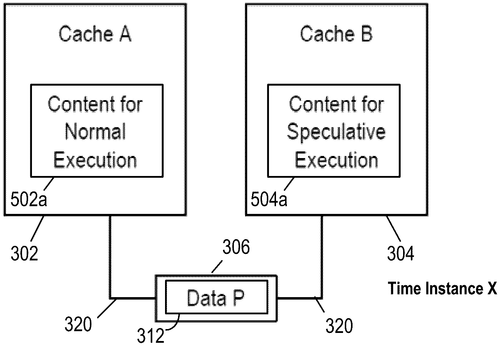
Micron Technology, Inc. has recently filed a patent for an intriguing cache system that aims to enhance the performance of memory systems. The patent describes a cache system consisting of two caches and a logic circuit, all controlled by a configurable data bit. This bit determines which cache to use when accessing the memory system, based on the current execution type. At first glance, this patent seems promising. An intelligent cache system that dynamically adapts to different execution types could potentially lead to significant improvements in processing speed and efficiency. By leveraging the strengths of each cache, the system could optimize data retrieval based on the specific needs of a given task. However, it is important to note that simply obtaining a patent does not guarantee that this technology will become a reality. Many patents remain purely theoretical and never see the light of day beyond the pages of legal documents. Additionally, the patent does not outline how the configurable data bit would be set or updated, leaving questions about its practical implementation. In the world of cache systems, many competitors already exist, offering varying levels of performance and reliability. Established players like Intel and AMD have their own cache solutions, and it remains to be seen how Micron's patented cache system would stack up against these competitors. Potential applications for such a cache system are numerous. From high-performance computing to artificial intelligence and big data analytics, any workload that relies heavily on memory access could benefit from a more flexible and adaptive cache system. It could potentially reduce latency, improve overall system performance, and enable more efficient multitasking. As with any innovation, it is essential to approach it with a mix of excitement and pragmatism. While Micron's cache system holds promise, there are still many technical and market challenges to overcome before it becomes a commercial product. Will this patent kick-start a new era of cache systems, or will it fade away like many others before it? Let us know your thoughts in the comments below.
Abstract
A cache system, having: a first cache; a second cache; a configurable data bit; and a logic circuit coupled to a processor to control the caches based on the configurable bit. When the configurable bit is in a first state, the logic circuit is configured to: implement commands for accessing a memory system via the first cache, when an execution type is a first type; and implement commands for accessing the memory system via the second cache, when the execution type is a second type. When the configurable data bit is in a second state, the logic circuit is configured to: implement commands for accessing the memory system via the second cache, when the execution type is the first type; and implement commands for accessing the memory system via the first cache, when the execution type is the second type. A cache system, having: a first cache; a second cache; a configurable data bit; and a logic circuit coupled to a processor to control the caches based on the configurable bit. When the configurable bit is in a first state, the logic circuit is configured to: implement commands for accessing a memory system via the first cache, when an execution type is a first type; and implement commands for accessing the memory system via the second cache, when the execution type is a second type. When the configurable data bit is in a second state, the logic circuit is configured to: implement commands for accessing the memory system via the second cache, when the execution type is the first type; and implement commands for accessing the memory system via the first cache, when the execution type is the second type.
US Patent 11860786
Micron Technology, Inc.
"New Patent by Micron Technology: Reconfigurable Compute Fabric Enables Efficient Execution of Compute Kernels"
What is this invention?
Kernel mapping to nodes in compute fabric
In compute fabric, nodes are seen,
With tiles, processing machines keen,
Algorithms are mapped,
By functions that clasped,
Resources in graphs, powerful and serene.
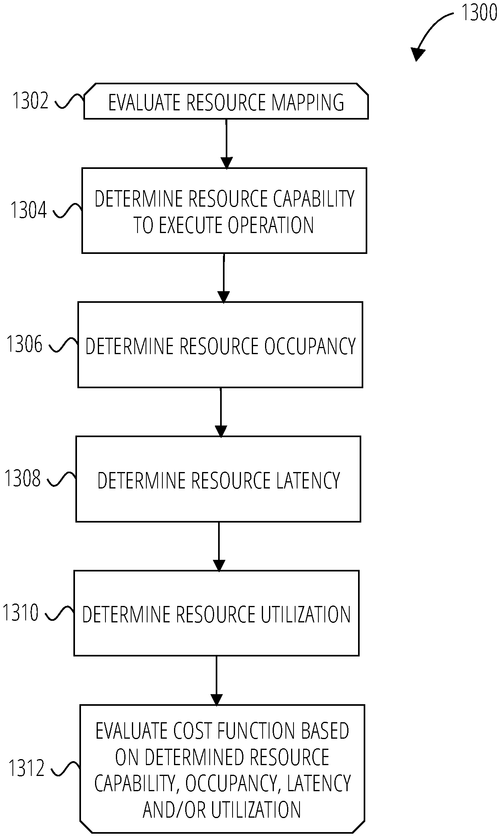
Micron Technology, Inc. has recently filed a patent for a reconfigurable compute fabric that could potentially revolutionize the way we process and store data. The concept involves multiple nodes, each containing multiple tiles with their own processing and storage elements. By parsing compute kernels into directed graphs and mapping them to specific node or tile resources, the system aims to optimize execution efficiency. At first glance, this patent seems to promise a significant advancement in computing technology. The ability to dynamically reconfigure hardware resources based on the specific requirements of a given task holds the potential to greatly enhance performance and power efficiency. This could be a game-changer for industries relying on computationally intensive applications, such as artificial intelligence, data analytics, and scientific simulations. However, it's important to note that filing a patent is not a guarantee that the invention will become a tangible product. Many factors come into play, such as technical limitations, market demand, and the feasibility of manufacturing at scale. It is also essential to consider the current competition in the market. Already, companies like Intel and NVIDIA dominate the realm of specialized processing units, offering powerful and efficient solutions. Nevertheless, if Micron's reconfigurable compute fabric does come to fruition, the potential use cases are intriguing. Imagine a data center that can dynamically allocate resources based on the current workload, optimizing both performance and energy consumption. Or consider a mobile device that adapts its processing capabilities to suit different applications, significantly extending battery life. While we wait to see if this patent will materialize as a viable product, one question comes to mind: How do you envision this reconfigurable compute fabric transforming the way we compute and store data? Share your thoughts in the comments below.
Abstract
A reconfigurable compute fabric can include multiple nodes, and each node can include multiple tiles with respective processing and storage elements. Compute kernels can be parsed into directed graphs and mapped to particular node or tile resources for execution. In an example, a branch-and-bound search algorithm can be used to perform the mapping. The algorithm can use a cost function to evaluate the resources based on capability, occupancy, or power consumption of the various node or tile resources. A reconfigurable compute fabric can include multiple nodes, and each node can include multiple tiles with respective processing and storage elements. Compute kernels can be parsed into directed graphs and mapped to particular node or tile resources for execution. In an example, a branch-and-bound search algorithm can be used to perform the mapping. The algorithm can use a cost function to evaluate the resources based on capability, occupancy, or power consumption of the various node or tile resources.
US Patent 11860800
****
"Revolutionary Blade Assembly Ensures Secure Cutting and Enhanced Efficiency for Vegetative Material"
What is this invention?
Multiuse blade assembly
In a land with blades that strive,
A vegetative tale does arrive.
Blade assembly, sharp and keen,
With hinges and a capture scheme,
Cutting greenery to help it thrive.
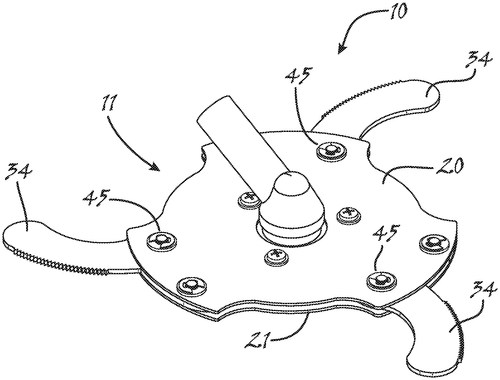
A recent patent application has caught the attention of technology enthusiasts, promising a potential breakthrough in the world of cutting vegetative material. The patent describes a blade assembly featuring a rotatable body and a set of inertially deployable blades that are hingedly affixed to the body. Each blade can be rotated between a retracted position and an extended position, and to ensure blade detachment is prevented in case of failure, a capture mechanism is employed. The design incorporates a guide plate positioned between a top cover and a bottom cover, serving as a reference point for desired hinge locations. Additionally, fixed blades can be integrated into the guide plate, while blade stops are added to maintain each blade in either the retracted position or an intermediate position. While this patent certainly presents an innovative concept, it is crucial to remember that not all patented inventions make it to market. Practical implementation, manufacturing feasibility, and competition from existing rival products are factors that will determine whether this idea becomes a reality. If this blade assembly were to be developed into an actual product, the potential uses could be numerous. It might find application in gardening tools, agricultural machinery, or even in the field of home appliances for efficient food preparation. However, only time will tell whether this patent will materialize into a product that can truly revolutionize the way we cut vegetative material. Now, I turn the discussion to you, dear readers. What are your thoughts on this patent? Do you see potential for this invention to make an impact in any specific industry? Leave your comments below and let's envision the future possibilities together.
Abstract
A blade assembly for cutting vegetative material includes a rotatable body and a number of inertially deployable blades hingedly affixed to the rotatable body. Each blade is rotatable between a first retracted position and a second extended position, and each blade cooperates with the body to form a capture mechanism preventing detachment of the blade from the body in the event the hinged affixation of the blade fails. The body includes a guide plate positioned between a top cover and a bottom cover. The covers provide hinge points for the blades at desired locations relative to the guide plate. The guide plate may include fixed blades, and blade stops may be implemented to retain each blade in the first retracted position or in a position intermediate the first retracted position and the second extended position. A blade assembly for cutting vegetative material includes a rotatable body and a number of inertially deployable blades hingedly affixed to the rotatable body. Each blade is rotatable between a first retracted position and a second extended position, and each blade cooperates with the body to form a capture mechanism preventing detachment of the blade from the body in the event the hinged affixation of the blade fails. The body includes a guide plate positioned between a top cover and a bottom cover. The covers provide hinge points for the blades at desired locations relative to the guide plate. The guide plate may include fixed blades, and blade stops may be implemented to retain each blade in the first retracted position or in a position intermediate the first retracted position and the second extended position.
US Patent 11856885
****
"New Patent Revolutionizes Round Hay Bale Handling for Industrial and Farm Vehicles"
What is this invention?
Self-aligning hay bale unroller
In the world of farms and machines,
A hay bale attachment, it seems,
Designed to engage,
And carry, with sage,
Unrolling bales with smooth routines.
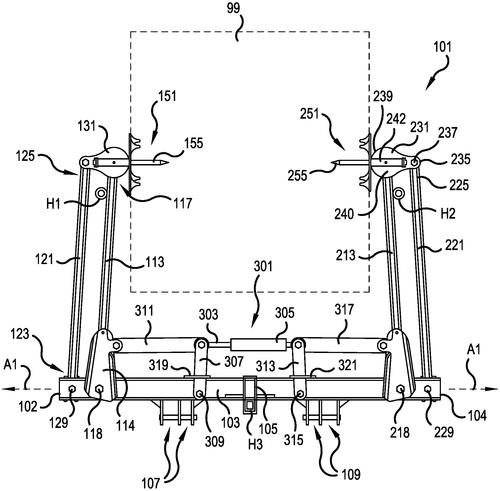
A new patent filed by an undisclosed inventor highlights an innovative attachment for industrial or farm vehicles that aims to streamline the process of handling and unrolling round hay bales. The attachment offers adjustable features to accommodate hay bales of various lengths, promising increased convenience and efficiency. The attachment consists of a robust support structure equipped with specialized connectors, allowing it to securely attach to the vehicle. At one end of the support structure, two arms are pivotably connected, each featuring a hay bale spear for engagement purposes. Another arm, referred to as the third arm, is pivotably connected near the opposite end of the support structure and carries a second hay bale spear that faces towards the first spear. While the patent description lacks details on how exactly the attachment engages, carries, and unrolls the round hay bales, it showcases an interesting concept that could potentially revolutionize the industry. Current methods of handling hay bales often involve manual labor or the use of heavy machinery, which may pose challenges in terms of cost, time, and manpower. This patent opens up avenues for farmers and industrial operators to visualize an attachment that simplifies and automates the process, offering potential benefits such as reduced labor requirements and increased productivity. Imagine the ability to effortlessly load and unload hay bales, with a mechanism that can adjust to bale sizes, making cumbersome and time-consuming processes a thing of the past. However, it is important to note that the existence of a patent does not necessarily imply that this invention will be turned into a marketable product. Many patents never materialize beyond the initial filing stage, remaining only as ideas on paper rather than practical tools in the real world. Considering the current market, there are already existing products such as bale spears, clamps, and other attachments designed to facilitate the handling of hay bales. Therefore, the success of this patent will depend on factors such as its functionality, cost-effectiveness, and whether it provides a significant advantage over the competition. In summary, this patent offers an intriguing concept for an attachment that simplifies the handling and unrolling of round hay bales. While the idea has potential benefits for the agricultural and industrial sectors, it also faces competition from existing products. Only time will tell if this invention will make it into production and become a game-changer in the industry. What are your thoughts on this patent? Can you envision any other potential uses for a hay bale handling attachment like this? Share your insights in the comments below.
Abstract
An attachment for an industrial or farm vehicle is designed to engage, carry and unroll a round hay bale. The attachment can be adjusted to interact with hay bales of various lengths. The attachment includes a support structure with features to attach to the vehicle. A first end of a first arm is pivotably connected proximate a first end of the support structure. A first end of a second arm is pivotably connected proximate the first end of the support structure. A spacing link is pivotably connected to second ends of the first and second arms. A first hay bale spear is attached to the spacing link. A third arm has a first end pivotably connected proximate a second end of the support structure. A second hale bay spear is attached proximate to a second end of the third arm and faces toward the first hay bale spear. An attachment for an industrial or farm vehicle is designed to engage, carry and unroll a round hay bale. The attachment can be adjusted to interact with hay bales of various lengths. The attachment includes a support structure with features to attach to the vehicle. A first end of a first arm is pivotably connected proximate a first end of the support structure. A first end of a second arm is pivotably connected proximate the first end of the support structure. A spacing link is pivotably connected to second ends of the first and second arms. A first hay bale spear is attached to the spacing link. A third arm has a first end pivotably connected proximate a second end of the support structure. A second hale bay spear is attached proximate to a second end of the third arm and faces toward the first hay bale spear.
US Patent 11856892
****
"Revolutionary Automated Mushroom Harvesting System Takes Farming to New Heights"
What is this invention?
Automated mushroom harvesting system
There once was a mushroom rack,
With an automated system on track,
A robot with frame,
Harvesting mushrooms became its aim,
Efficiently sliding up and down, no lack.
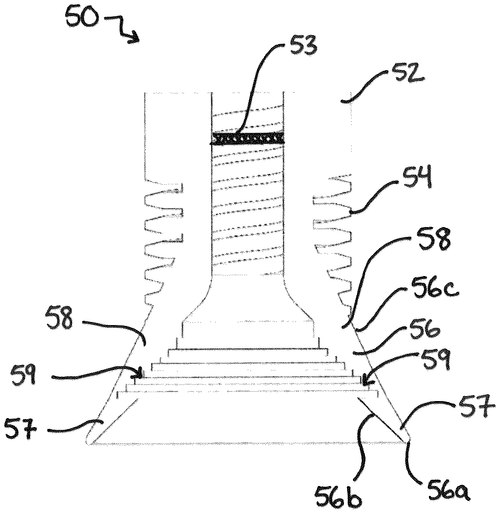
An exciting new patent for an automated mushroom harvesting system has been making waves in the agricultural technology sector. With a vertical mushroom rack as the foundation, this system includes a robot equipped with a frame mounted to a vertical carriage assembly. What sets this innovation apart is its use of a SCARA arm, which is capable of moving in a vertical direction along a mast, guided by a vertical stage. The SCARA arm's horizontal movement allows for efficient mushroom harvesting, as it can reach above the surface of the mushroom bed, extending into and out of the confines of the mushroom rack. Additionally, the vertical stage can move the SCARA arm vertically, enabling access to mushrooms in various beds and on different levels of the vertical mushroom rack. Notably, the end effector includes a helically reinforced neck and a graduated elasticity modulus. This design ensures that the lower elasticity modulus in the neck prevents unnecessary damage, while the higher elasticity in the cup allows for a secure grip during harvest. While this automated mushroom harvesting system is an intriguing prospect, it is important to approach this patent with a dose of realism. Although the idea presents significant potential, practical challenges may arise during the process of turning it into a viable product. Competitor products in the agricultural automation market, such as automated vegetable harvesters, might already have an advantage and could potentially serve as substitutes for this specific invention. However, the possibilities for integrating this technology into mushroom cultivation are fascinating. Beyond commercial mushroom farms, this system could potentially find applications in urban farming initiatives or even home gardens, providing efficient and precise mushroom harvesting capabilities. Intriguingly, this patent raises questions about the future of automation in agriculture. How far can we go in replacing human labor with robotics and AI in our farming practices? And what implications will this have for our existing food production systems? Let us know your thoughts in the comments below.
Abstract
An automated mushroom harvesting system for mounting to a vertical mushroom rack comprises a robot having a frame mounted to a vertical carriage assembly. A SCARA arm is slidably mounted to the vertical carriage assembly by a vertical stage, operable to move the SCARA arm along a vertical mast. The SCARA arm moves the end effector in a horizontal plane for harvesting mushrooms, above the surface of the mushroom bed and into and out of the confines of the mushroom rack, and the vertical stage moves the SCARA arm in a vertical direction so as to access the mushrooms in a bed and to access mushroom beds on different levels of the vertical mushroom rack. An end effector having a helically reinforced neck and a graduated elasticity modulus, with a lower elasticity modulus in the neck and a higher elasticity in the cup, is also provided. An automated mushroom harvesting system for mounting to a vertical mushroom rack comprises a robot having a frame mounted to a vertical carriage assembly. A SCARA arm is slidably mounted to the vertical carriage assembly by a vertical stage, operable to move the SCARA arm along a vertical mast. The SCARA arm moves the end effector in a horizontal plane for harvesting mushrooms, above the surface of the mushroom bed and into and out of the confines of the mushroom rack, and the vertical stage moves the SCARA arm in a vertical direction so as to access the mushrooms in a bed and to access mushroom beds on different levels of the vertical mushroom rack. An end effector having a helically reinforced neck and a graduated elasticity modulus, with a lower elasticity modulus in the neck and a higher elasticity in the cup, is also provided.
US Patent 11856898
****
"New Patent Unveils Canola Variety 18GG0453L with Enhanced Traits and Crossbreeding Innovations"
What is this invention?
Canola hybrid 18GG0453L
In labs where scientists toil away,
Creating canola every which way,
The 18GG0453L
Is a mighty seed, I can tell,
With traits introgressed, it's here to stay.

In a recent patent application, a canola variety designated as 18GG0453L and its associated seed, plants, and plant parts have been described. This canola variety is the result of a cross between different inbred varieties, with methods outlined for producing more of this genetically modified canola. While the details of the patent describe various methods for producing and manipulating this canola variety, it remains to be seen whether these techniques will actually lead to a tangible product. The patent does not explicitly mention any plans for commercialization or whether this variety has any advantage over existing canola varieties in terms of yield, disease resistance, or other desirable traits. It's worth noting that the canola market has been dominated by a few major players, such as Monsanto's Roundup Ready canola and BASF's Clearfield canola. These genetically modified varieties have been widely adopted by farmers due to their beneficial traits. With that in mind, it is unclear how this new canola variety might differentiate itself from the competition. That said, canola is a highly versatile crop with numerous applications. It is commonly used for cooking oil, animal feed, and biodiesel production, among others. This new variety could potentially have improvements in any of these areas, making it more appealing to farmers and end-users alike. As with any patent, it's important to consider the potential impact of such developments on the environment, biodiversity, and food safety. Genetically modified crops often spark controversial discussions, and it would be interesting to hear readers' thoughts on the matter. Do you believe that genetically modified canola varieties are a necessary innovation to meet global food demands, or do you have concerns about their long-term effects? Share your thoughts in the comments below.
Abstract
Provided is a canola variety designated 18GG0453L and seed, plants and plant parts thereof produced from a cross of inbred varieties. Methods for producing a canola variety comprise crossing canola variety 18GG0453L with another canola plant. Methods for producing a canola plant containing in its genetic material one or more traits introgressed into 18GG0453L through backcross conversion and/or transformation, and to the canola seed, plant and plant part produced thereby are described. Canola variety, the seed, the plant produced from the seed, plant parts and variants, mutants, and minor modifications of canola variety are disclosed. Provided is a canola variety designated 18GG0453L and seed, plants and plant parts thereof produced from a cross of inbred varieties. Methods for producing a canola variety comprise crossing canola variety 18GG0453L with another canola plant. Methods for producing a canola plant containing in its genetic material one or more traits introgressed into 18GG0453L through backcross conversion and/or transformation, and to the canola seed, plant and plant part produced thereby are described. Canola variety, the seed, the plant produced from the seed, plant parts and variants, mutants, and minor modifications of canola variety are disclosed.
US Patent 11856905
****
"Pioneering Patent Unveils Revolutionary Maize Variety X18R501 – A Game-Changer in Genetic Agriculture"
What is this invention?
Maize hybrid X18R501
In the realm of maize, variety unfolds,
X18R501, a story to be told.
Through crossing and transformation's guise,
New traits emerge, a wondrous surprise.
With methods, we shape the future's mold.

A recent patent application has introduced a new maize variety, X18R501, which promises to bring about advancements in agricultural practices. According to the patent, X18R501 is created through the deliberate crossing of specific inbred maize varieties, resulting in a novel hybrid with unique characteristics. While the patent description is filled with technical terminology, it remains unclear how this variety differs from competitors in the market. The document mentions the potential for backcrossing or genetic transformation to incorporate desired traits into X18R501, but specific traits or applications are not disclosed. This lack of specificity makes it difficult to evaluate the practical implications of this invention. Corn is a staple crop globally, used in various industries such as biofuel, food production, and animal feed. The introduction of a novel maize variety could potentially enhance productivity, disease resistance, or improve the overall quality of corn-based products. However, without more information on X18R501's unique attributes, it is challenging to gauge its potential impact. Additionally, the patent mentions the possibility of producing derivatives or mutants of X18R501, which could be interesting avenues for experimentation. Exploring new maize varieties and their characteristics is crucial, especially in a time when climate change and pests pose significant challenges to agriculture. Considering the importance of maize in our global food system, it is encouraging to see ongoing efforts to develop innovative varieties. However, the true value and impact of X18R501 can only be fully determined once more details are made available. As of now, it is uncertain whether this invention will transition into a tangible product that can benefit farmers and consumers alike. Do you think the introduction of a new maize variety like X18R501 could have significant implications in the agricultural industry? Share your thoughts and opinions in the comments below.
Abstract
A novel maize variety designated X18R501 and seed, plants and plant parts thereof are produced by crossing inbred maize varieties. Methods for producing a maize plant by crossing hybrid maize variety X18R501 with another maize plant are disclosed. Methods for producing a maize plant containing in its genetic material one or more traits introgressed into X18R501 through backcrossing or genetic transformation, and to the maize seed, plant and plant part produced thereby are described. Maize variety X18R501, the seed, the plant produced from the seed, and variants, mutants, and minor modifications of maize variety X18R501 are provided. Methods for producing maize varieties derived from maize variety X18R501 and methods of using maize variety X18R501 are disclosed. A novel maize variety designated X18R501 and seed, plants and plant parts thereof are produced by crossing inbred maize varieties. Methods for producing a maize plant by crossing hybrid maize variety X18R501 with another maize plant are disclosed. Methods for producing a maize plant containing in its genetic material one or more traits introgressed into X18R501 through backcrossing or genetic transformation, and to the maize seed, plant and plant part produced thereby are described. Maize variety X18R501, the seed, the plant produced from the seed, and variants, mutants, and minor modifications of maize variety X18R501 are provided. Methods for producing maize varieties derived from maize variety X18R501 and methods of using maize variety X18R501 are disclosed.
US Patent 11856906